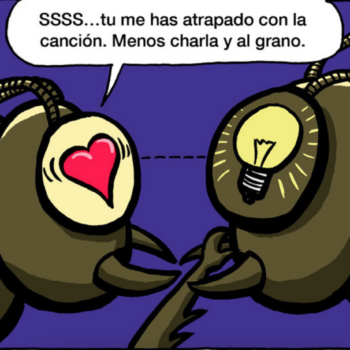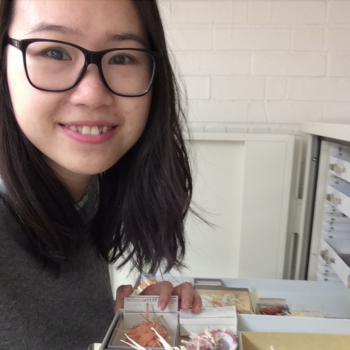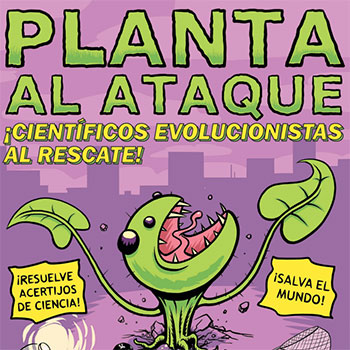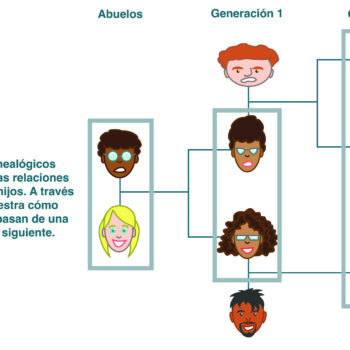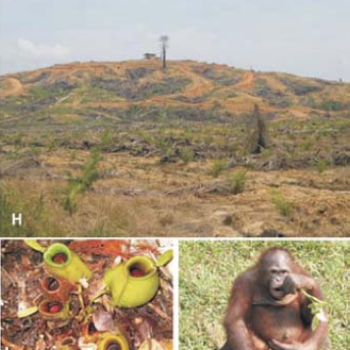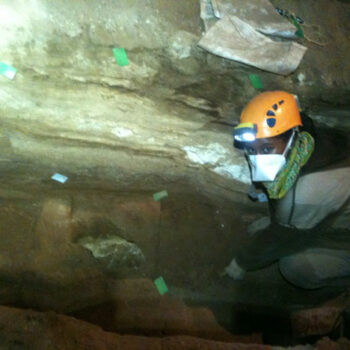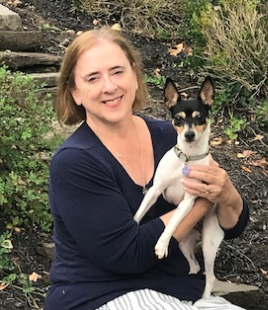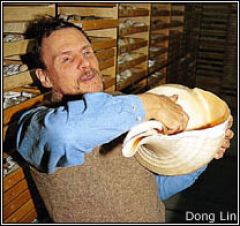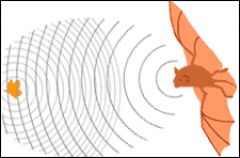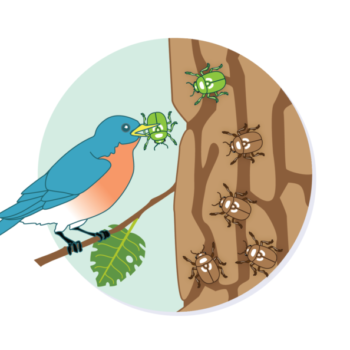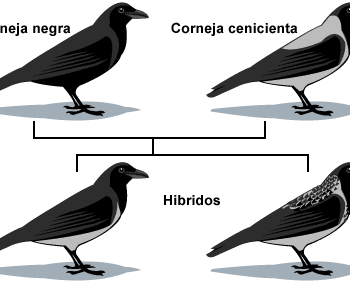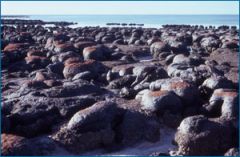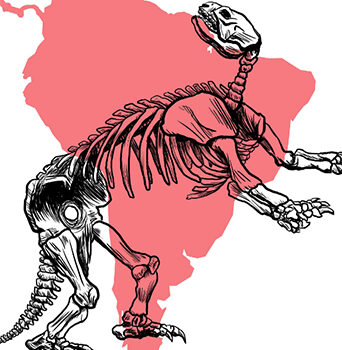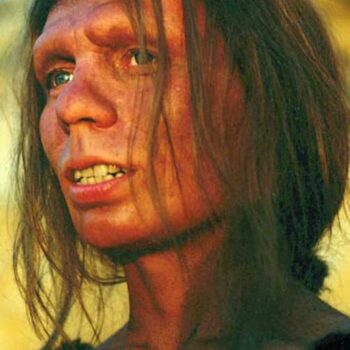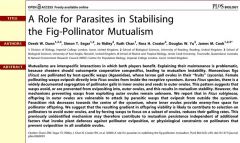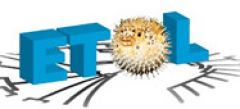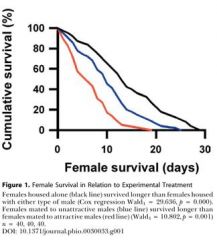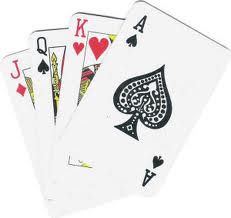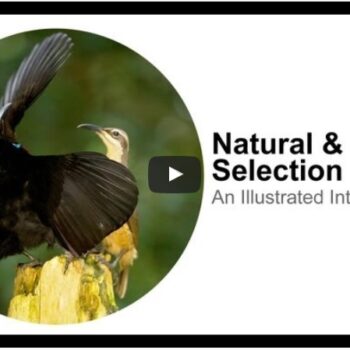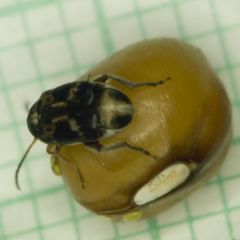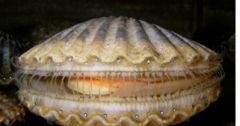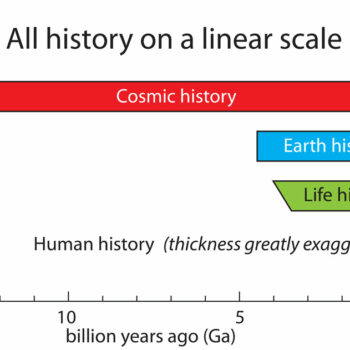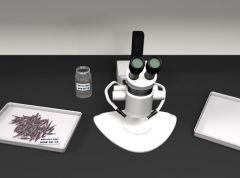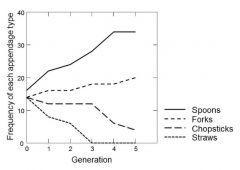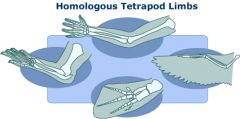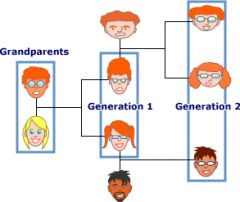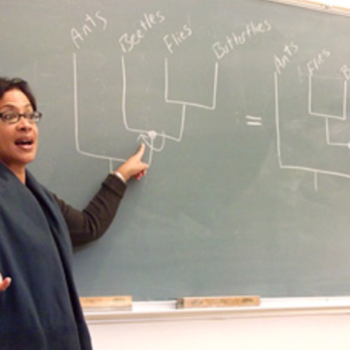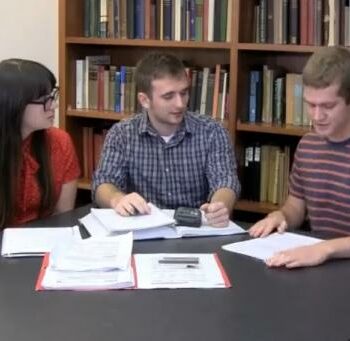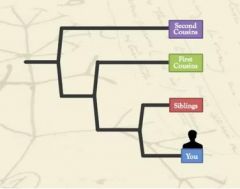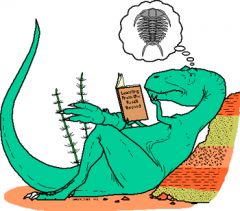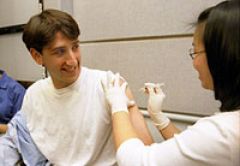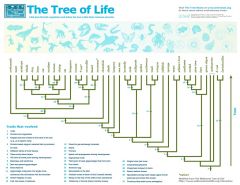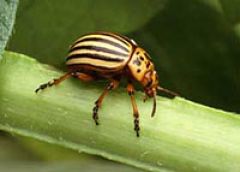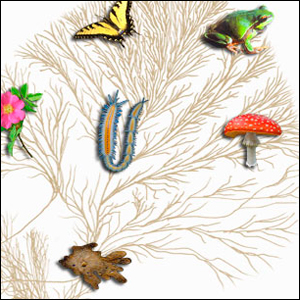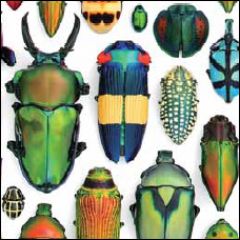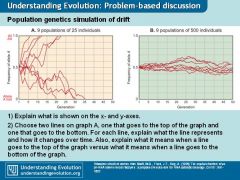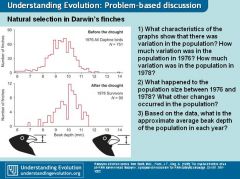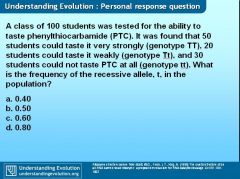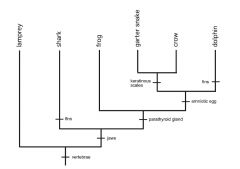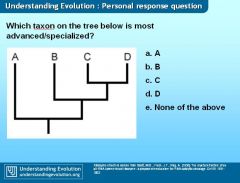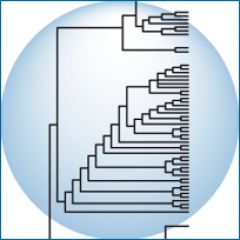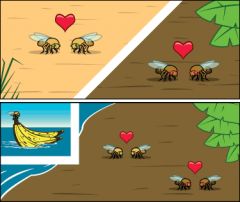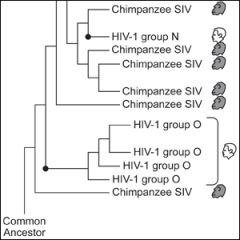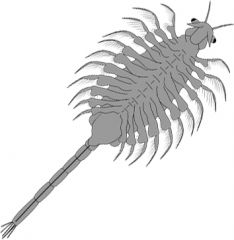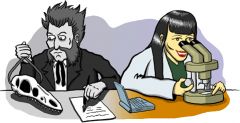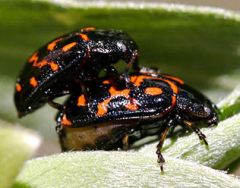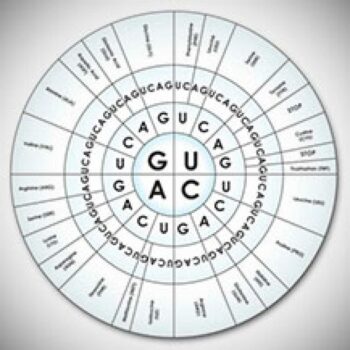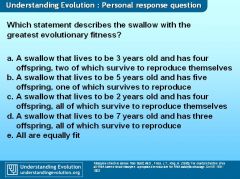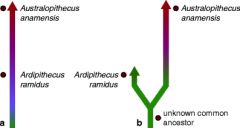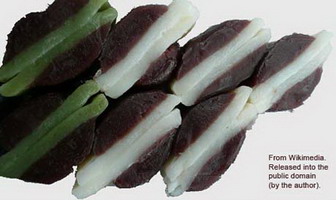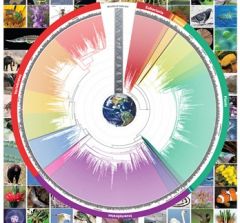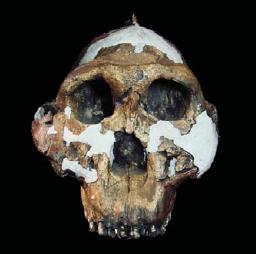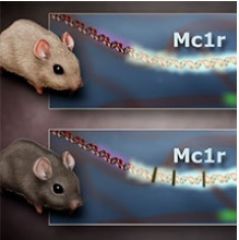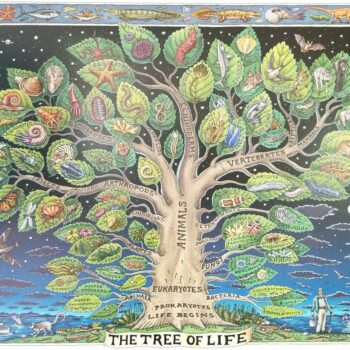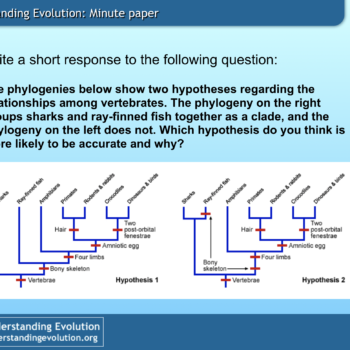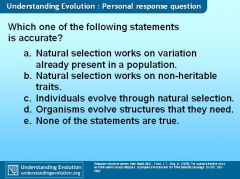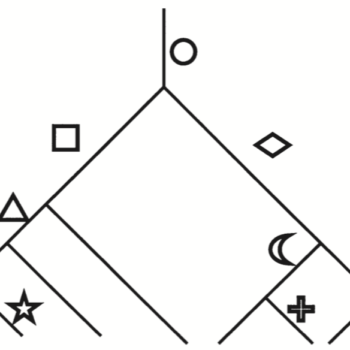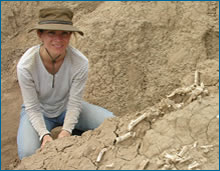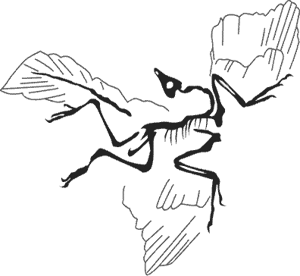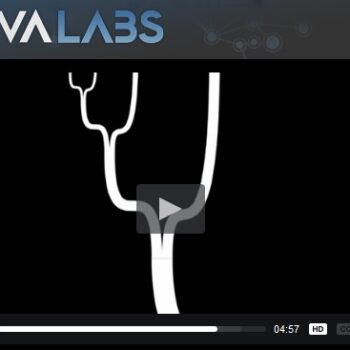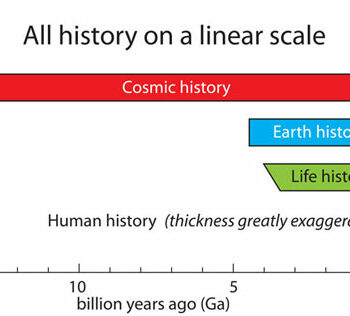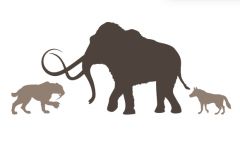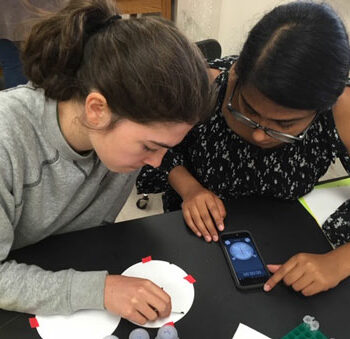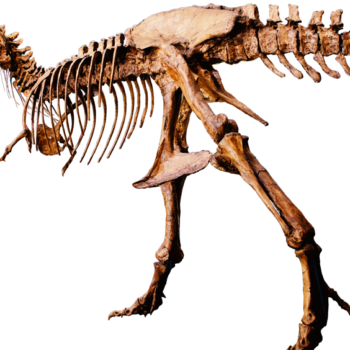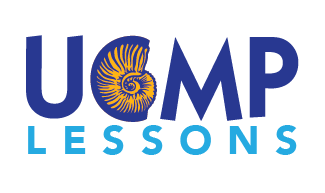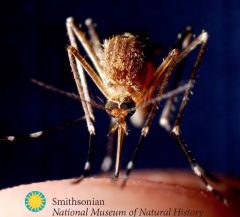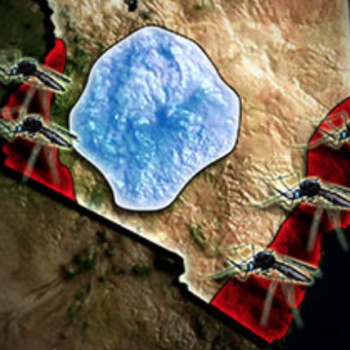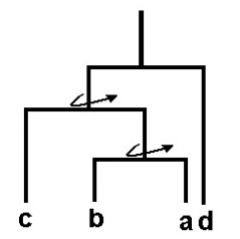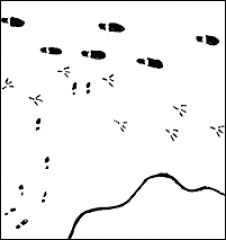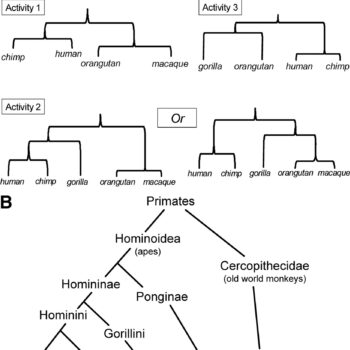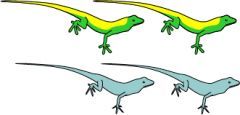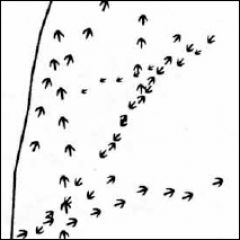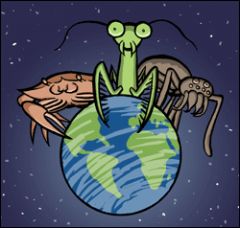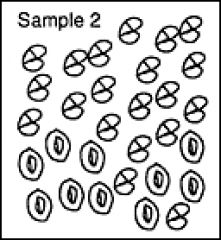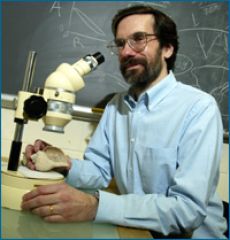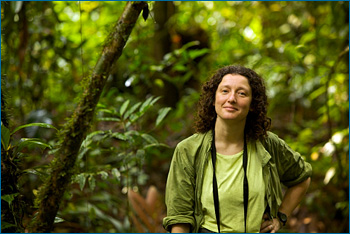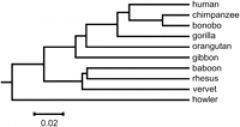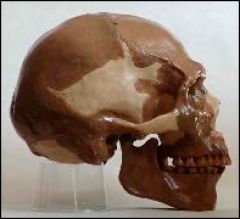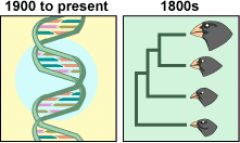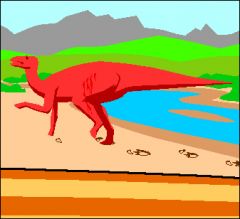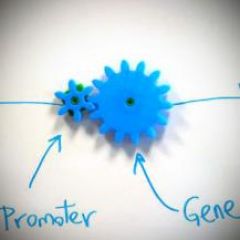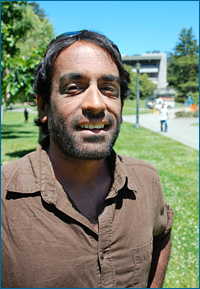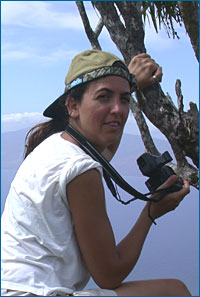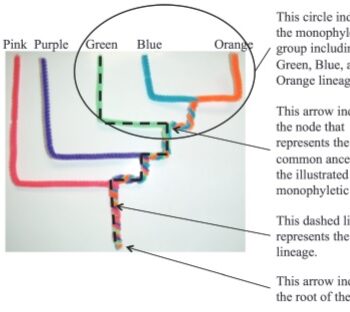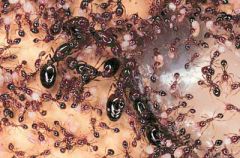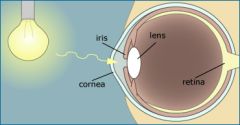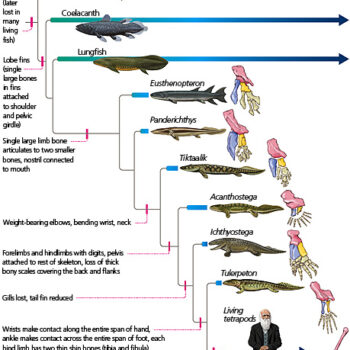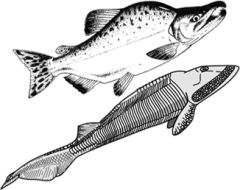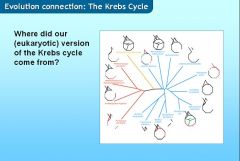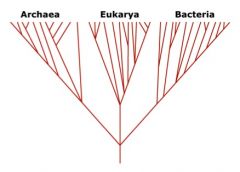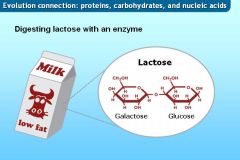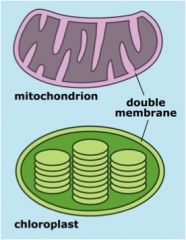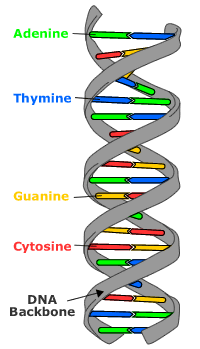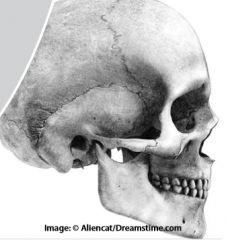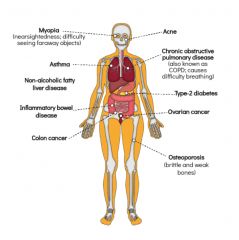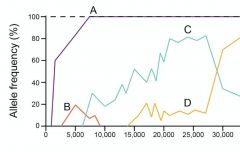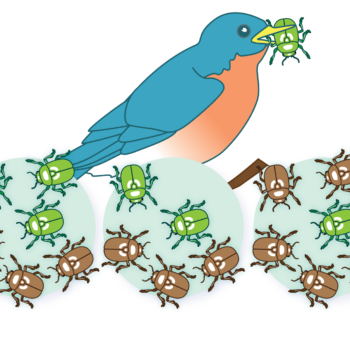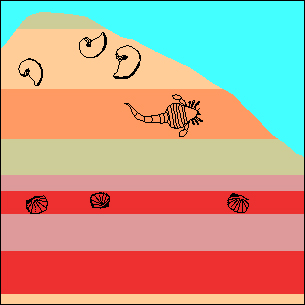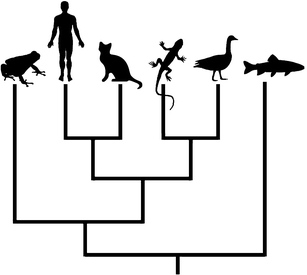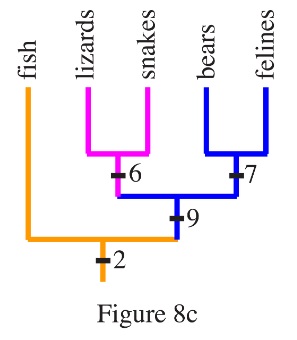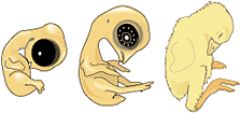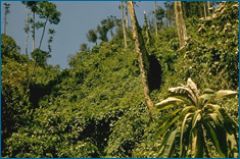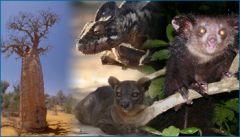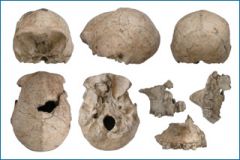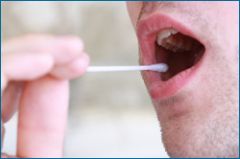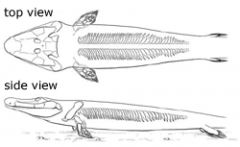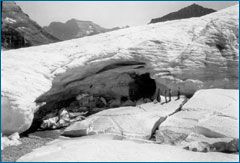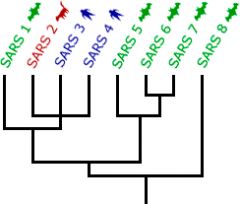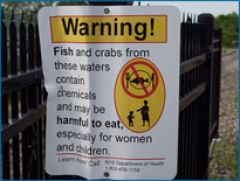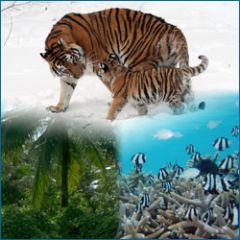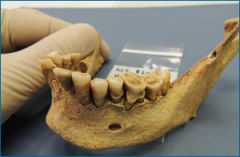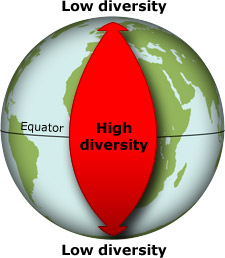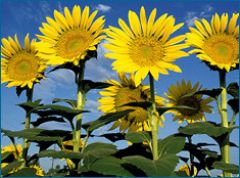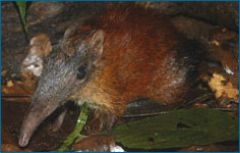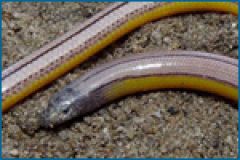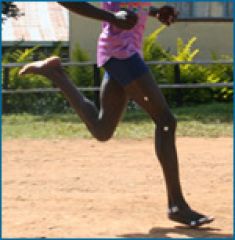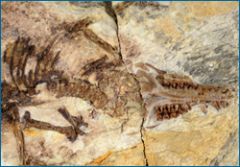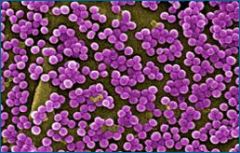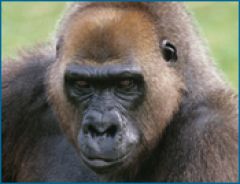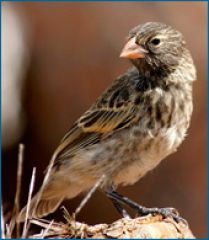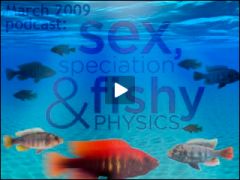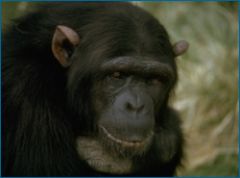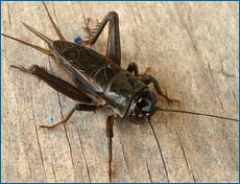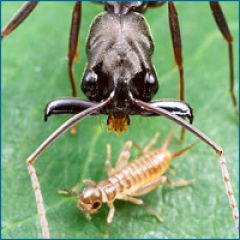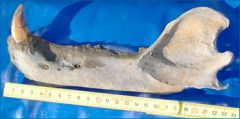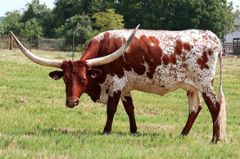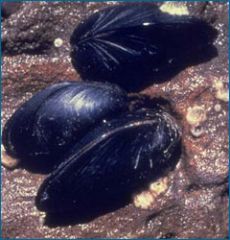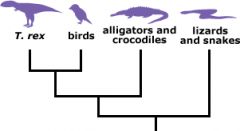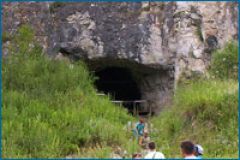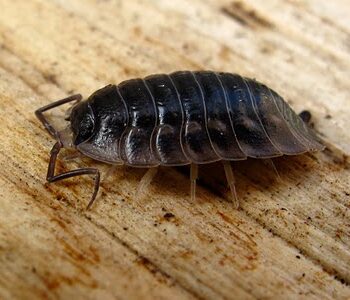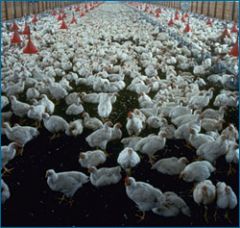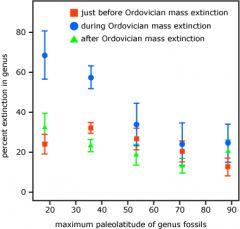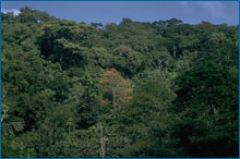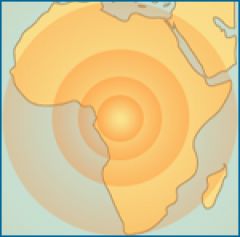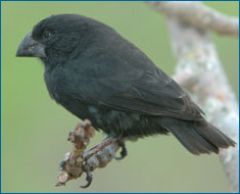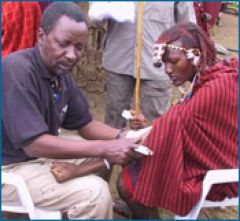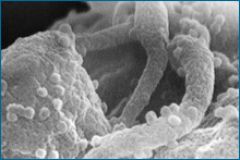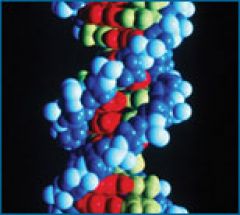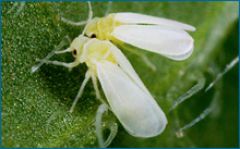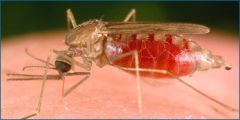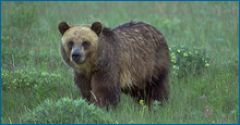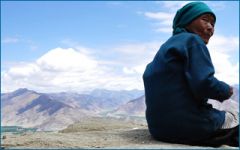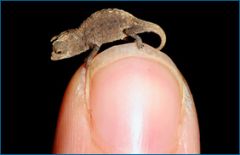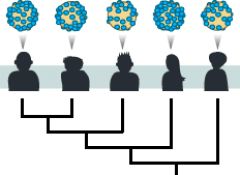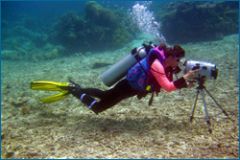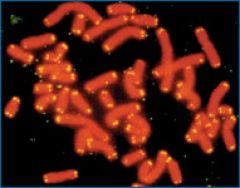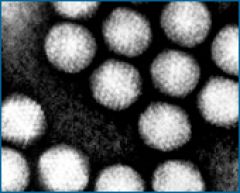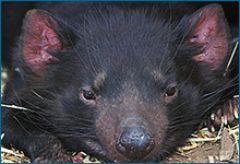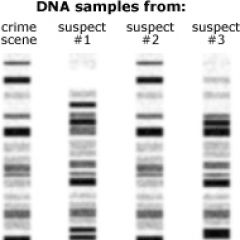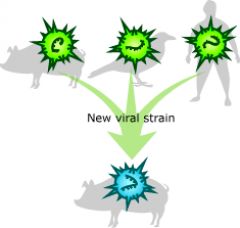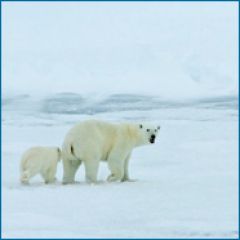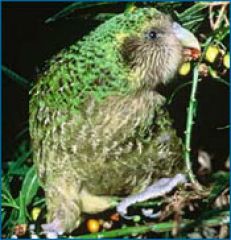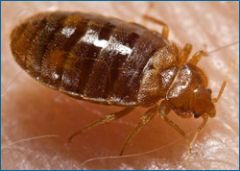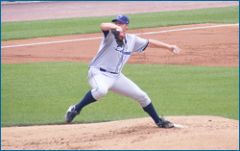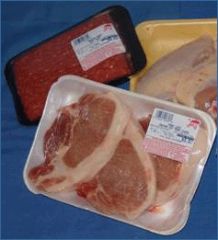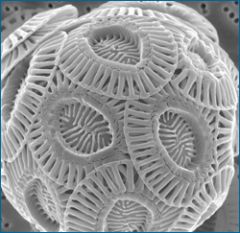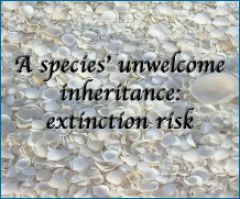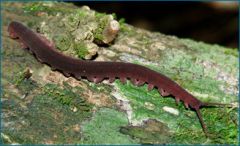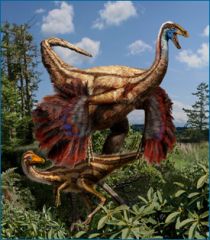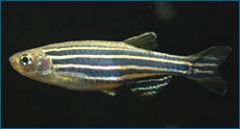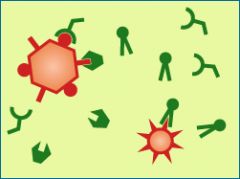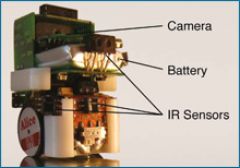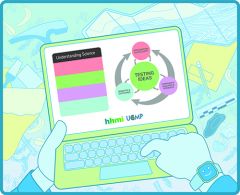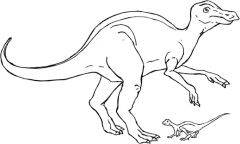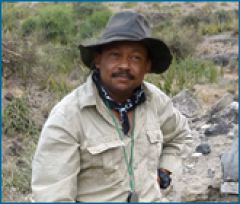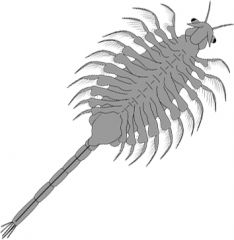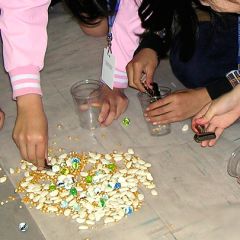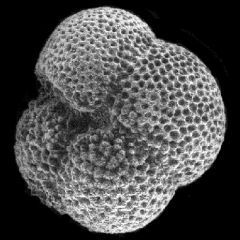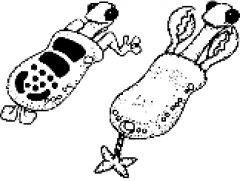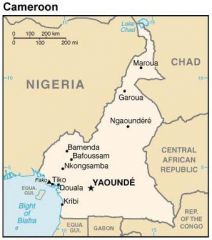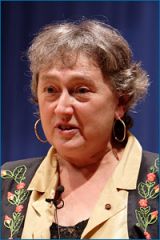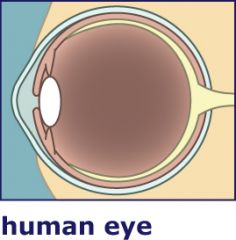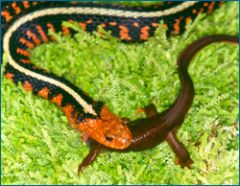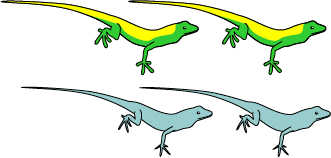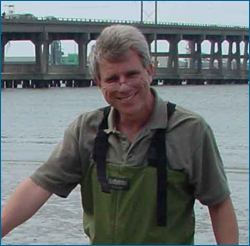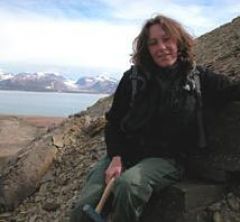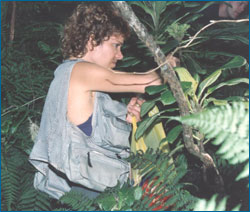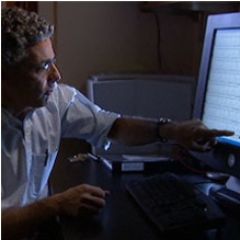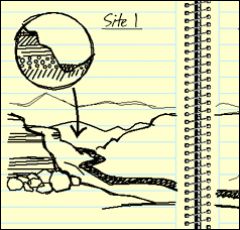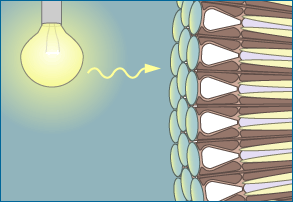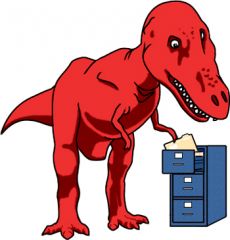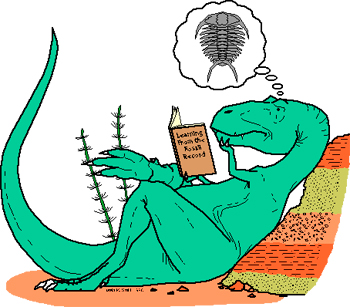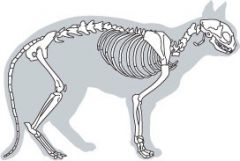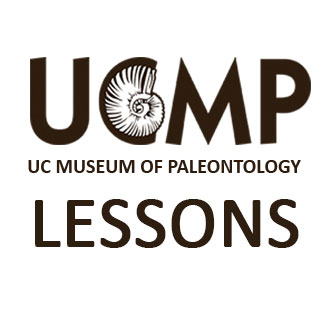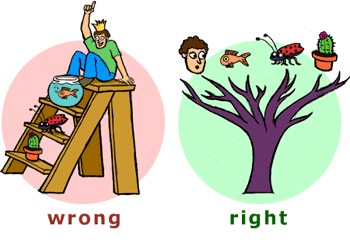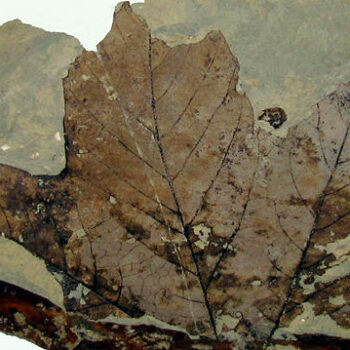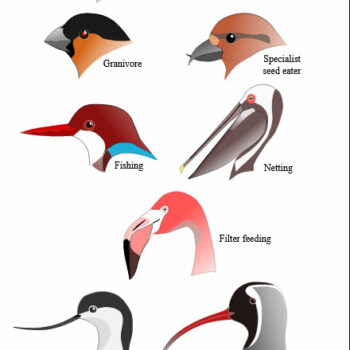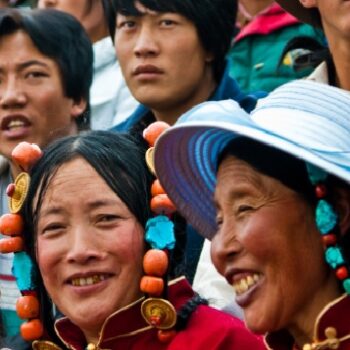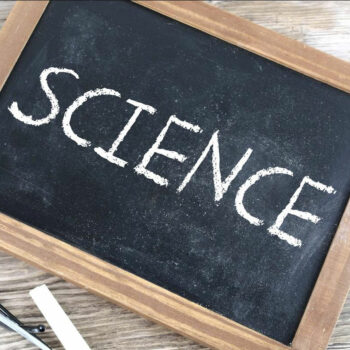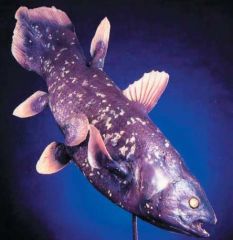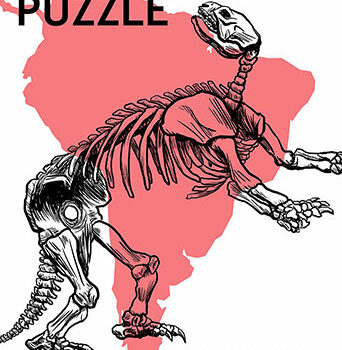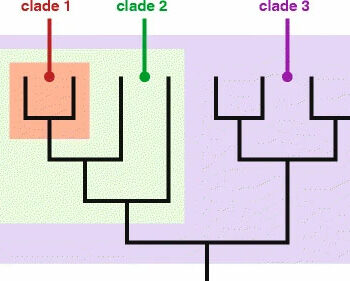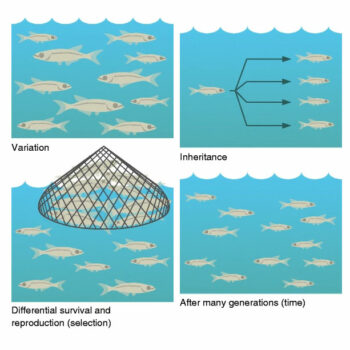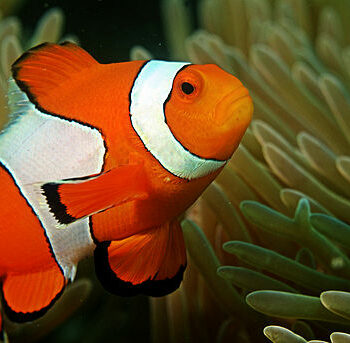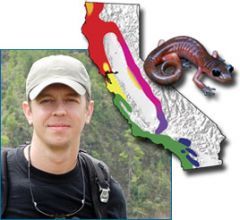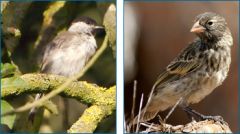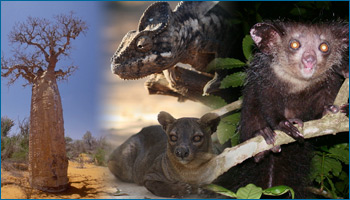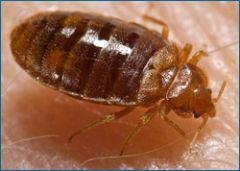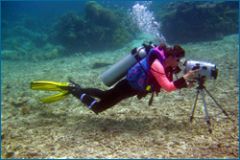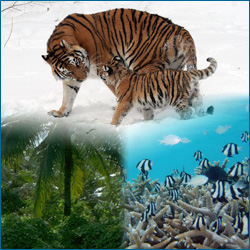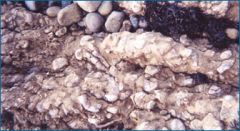Search by:
Found 318 resources:
La Supervivencia del más Astuto
Grade Level(s):
- 6-8
- 9-12
Source:
- UC Museum of Paleontology
Resource type:
- Comic
Time: 10 minutes
Overview
Este cómic nos habla de los esfuerzos de un grillo macho para atraer a una pareja. Y en el proceso, revela (destruye) algunos típicos malentendidos sobre lo que significa estar evolutivamente “adaptado”.
Extinction vulnerability with Shan Huang, David Jablonski, and Stewart Edie
Grade Level(s):
- 9-12
- 13-16
Source:
- UC Museum of Paleontology
Resource type:
- Article
- Classroom activity
Time: 1.5 hrs
Overview
In this article (and the linked assignments and student readings), students examine and interpret data that Shan, David, and Stewart used to investigate whether the mollusk species that humans eat are inherently vulnerable to extinction. Use the tabs at the bottom of the feature to find related videos, assignments, and lessons to build this example into a lesson sequence on extinction.
Planta al ataque
Grade Level(s):
- 6-8
- 9-12
Source:
- UC Museum of Paleontology
Resource type:
- Classroom activity
- Comic
Time: 50 minutes
Overview
En este cómic/libro de actividades, conocerás a científicos que utilizan ideas evolutivas para resolver problemas médicos. También aprenderás sobre los árboles evolutivos mientras resuelves rompecabezas científicos y completas una actividad.
Plant on a Rampage
Grade Level(s):
- 6-8
- 9-12
Source:
- UC Museum of Paleontology
Resource type:
- Classroom activity
- Comic
Time: 50 minutes
Overview
In this printable comic/activity book, you'll meet scientists who use evolutionary ideas to solve medical problems. You'll also learn about evolutionary trees while you solve science puzzles and complete a craft.
Semejanzas y diferencias: Comprendamos las homologías y evolución convergente (nivel secundaria)
Grade Level(s):
- 6-8
Source:
- UC Museum of Paleontology
Resource type:
- Online activity or lab
Time: 30 minutes
Overview
Esta investigación interactiva explica qué son las homologías, cómo reconocerlas y cómo es que evolucionan.
Evidencias de la Evolución: La ciencia de la evolución
Grade Level(s):
- 6-8
- 9-12
Source:
- UC Museum of Paleontology
Resource type:
- Tutorial
Time: 30-40 minutes
Overview
Biodiversity loss threatens human well-being
Grade Level(s):
- 13-16
Source:
- Rebecca Tarvin
Resource type:
- Annotated journal article
Time: 1 hour
Overview
This research article examines connections between biodiversity loss and ecosystem functions that matter to humans, such as providing access to food, fuel, shelter, and water. This open-access article has been translated into Spanish and Chinese by students in the UC Berkeley Integrative Biology program.
Extinction with Melissa Kemp and Liz Hadly
Grade Level(s):
- 9-12
- 13-16
Source:
- UC Museum of Paleontology
Resource type:
- Article
- Classroom activity
Time: 1.5 hours
Overview
In this article (and the linked assignments and student readings), students examine and interpret data that Melissa and Liz used to study the extinction bias in Caribbean lizards. Use the tabs at the bottom of the feature to find related videos, assignments, and lessons to build this example into a lesson sequence on extinction.
Semejanzas y diferencias: Comprendamos las homologías y evolución convergente (nivel bachillerato)
Grade Level(s):
- 9-12
Source:
- UC Museum of Paleontology
Resource type:
- Online activity or lab
Time: 30 minutes
Overview
Esta investigación interactiva explica qué son las homologías, cómo reconocerlas y cómo es que evolucionan.
The causes of mutation with Molly Przeworski and Felix Wu
Grade Level(s):
- 13-16
Source:
- UC Museum of Paleontology
Resource type:
- Classroom activity
Time: 1.5 hours
Overview
In this article (and the linked assignments and student readings), students examine and interpret data that Molly and Felix used to study the causes of mutations that matter most for evolution. Use the tabs at the bottom of the feature to find related videos, assignments, and lessons to build this example into a lesson sequence on mutation.
Omicron y el caso de la evolución escondida
Grade Level(s):
- 9-12
- 13-16
Source:
- UC Museum of Paleontology
Resource type:
- Evo in the News article
Time: 30 min
Overview
Durante el último mes, las cepas del SARS-CoV-2 Omicron han dominado los noticiarios del mundo. Esta variante de rápida transmisión ha llevado a limitar viajes, a cancelar planes de vacaciones, al agotamiento de los kits de pruebas, a la vuelta de los confinamientos, y además a un asombroso número de nuevos casos de COVID-19. Los científicos rápidamente se han puesto a estudiar Omicron, intentando entender qué tan rápido se transmite, qué tanto nos enferma, y si es resistente a los tratamientos, a las vacunas, y a los anticuerpos de infecciones de COVID previas. Necesitamos revisar todas estas cuestiones porque Omicron es muy diferente de otras cepas de coronavirus. Omicron ha acumulado más de 50 nuevas mutaciones en comparación con la cepa que empezó la pandemia. Además Omicron no es un descendiente de la cepa Delta, responsable de la anterior ola de infecciones. De hecho, Omicron es tan diferente de otras variantes que parece que ha estado evolucionando por su cuenta durante muchos meses. Y esto nos conduce a otro misterio que los científicos están tratando de resolver: ¿dónde estaba Omicron escondido mientras toda esta evolución tenía lugar?
Evo in the news: Omicron and the case of the hidden evolution
Grade Level(s):
- 9-12
- 13-16
Source:
- UC Museum of Paleontology
Resource type:
- Evo in the News article
Time: 30 min
Overview
This news brief from January 2022, explores the evolutionary mystery at the heart of the Omicron COVID-19 surge.
Artificial Selection with Elaine Ostrander and Team
Grade Level(s):
- 9-12
- 13-16
Source:
- UC Museum of Paleontology
Resource type:
- Classroom activity
Time: 1 hr
Overview
In this article (and the linked assignments and student readings), students examine and interpret data that the team used to study the genes undergoing artificial selection during the development of different dog breeds. Use the tabs at the bottom of the feature to find related videos, assignments, and lessons to build this example into a lesson sequence on artificial selection.
Sexual Selection with Maydianne Andrade
Grade Level(s):
- 9-12
- 13-16
Source:
- UC Museum of Paleontology
Resource type:
- Classroom activity
Time: 1 hour
Overview
In this article (and the linked assignments and student readings), students examine and interpret data that Maydianne collected to help her figure out why redback spiders evolved a mating behavior in which the male spider is often killed by the female spider. Use the tabs at the bottom of the feature to find related videos, assignments, and lessons to build this example into a lesson sequence on sexual selection.
Interview: Geerat Vermeij on the Fossil record
Grade Level(s):
- 9-12
Source:
- California Academy of Sciences
Resource type:
- Interview with Scientist
Time: 20-30 minutes
Overview
This interview with MacArthur Fellow and paleobiologist, Geerat Vermeij, covers much ground, including adaptations in the mollusks he studies, evolutionary arms races, punctuated equilibrium, extinctions, macroevolution, and the value of diversity.
La historia de la vida: La observación de los patrones
Grade Level(s):
- 9-12
Source:
- UC Museum of Paleontology
Resource type:
- Tutorial
Time: 30-40 minutes
Overview
La ciencia usa muchas evidencias diferentes para reconstruir los árboles filogenéticos que nos muestran como se relacionan las especies entre sí.
Este artículo se encuentra en Evolución 101.
Mecanismos: Los procesos de la evolución
Grade Level(s):
- 9-12
Source:
- UC Museum of Paleontology
Resource type:
- Tutorial
Time: Varies
Overview
Aprende sobre los procesos básicos que han moldeado la vida y producido su asombrosa diversidad.
Este artículo se encuentra en Evolución 101.
Selección natural
Grade Level(s):
- 9-12
Source:
- UC Museum of Paleontology
Resource type:
- Tutorial
Time: 30-40 minutes
Overview
La idea más famosa de Darwin, “La selección Natural”, explica la gran diversidad de la vida. Aprende cómo funciona, explora algunos ejemplos, y descubre cómo evitar falsas ideas.
Este artículo se encuentra en Evolución 101.
La especiación
Grade Level(s):
- 9-12
Source:
- UC Museum of Paleontology
Resource type:
- Tutorial
Time: 30 minutes
Overview
Explicar qué es una especie no es tan fácil como puede parecer. Descubre como la biología define especie y cómo surgen las nuevas especies.
Este artículo se encuentra en Evolución 101.
Del caldo primigenio a las células: El origen de la vida
Grade Level(s):
- 9-12
Source:
- UC Museum of Paleontology
Resource type:
- Tutorial
Time: 20 minutes
Overview
Profundiza en los conocimientos actuales sobre el origen de la vida y en cómo los científicos y las científicas son capaces de investigar en los detalles de acontecimientos tan antiguos.
Un rompecabezas Pleistoceno: Extinctión en América del Sur
Grade Level(s):
- 6-8
- 9-12
Source:
- UC Museum of Paleontology
Resource type:
- Comic
Time: 20 minutes
Overview
En este comic podrás seguir la investigación que hicieron María y Miguel para resolver un misterio paleontológico. Hace más de 11000 años, más del 80% de las especies de grandes animales de Sudamérica se extinguieron. ¿Por qué pasó? (Disponible en inglés, español y portugués.)
Great Fossil Find
Grade Level(s):
- 6-8
- 9-12
- 13-16
Source:
- ENSI
Resource type:
- Classroom activity
Time: 40 minutes
Overview
Students are taken on an imaginary fossil hunt and hypothesize as to the identity of the creature they discover. Students revise their hypotheses as new evidence is "found."
Evo in the news: Human evolutionary history impacts our COVID-19 risk
Grade Level(s):
- 9-12
- 13-16
Source:
- UC Museum of Paleontology
Resource type:
- Evo in the News article
Time: 30 minutes
Overview
This news brief from November 2020 explains how a gene from Neanderthals made its way into human populations and now affects COVID-19 risk.
La historia evolutiva del ser humano afecta nuestro riesgo de padecer COVID-19
Grade Level(s):
- 9-12
- 13-16
Source:
- UC Museum of Paleontology
Resource type:
- Evo in the News article
Time: 30 minutes
Overview
Este resumen de noticias de noviembre de 2020 explica cómo un gen de los Neandertales que se introdujo en las poblaciones de los humanos modernos, afecta al riesgo de padecer COVID-19.
Journal Club Toolkit
Grade Level(s):
- 13-16
Source:
- UC Museum of Paleontology
Resource type:
- Annotated journal article
Time: Several class periods
Overview
This set of teaching materials aims to help instructors engage their students with the primary literature in evolutionary biology through a "journal club" that can be implemented in a discussion section or smaller class. It includes several helpful tools: annotated articles, a reading guide, additional suggested reading, and tips for students leading a discussion of a journal article.
Investigating a Deep Sea Mystery
Grade Level(s):
- 9-12
Source:
- ETOL
Resource type:
- Lab activity
Time: 4-5 class periods
Overview
In this lab activity, students examine authentic morphological and phylogenetic data of three fish families and then pose and test alternative hypotheses about the fishes' classification.
Mate choice and fitness consequences
Grade Level(s):
- 13-16
Source:
- UC Museum of Paleontology
Resource type:
- Annotated journal article
Time: 1 hour
Overview
Students read a 2005 paper on the fitness consequences of mate choice alongside an interactive guide that asks the reader to answer key questions about each section of the article.
Stabilization of the fig-pollinator mutualism
Grade Level(s):
- 13-16
Source:
- UC Museum of Paleontology
Resource type:
- Annotated journal article
Time: 1 hour
Overview
Students read a 2008 paper on the role of parasites in stabilizing the fig-pollinator mutualism alongside an interactive guide that explains each section of the paper and draws the reader's attention to important points in the article.
Selection and evolution with a deck of cards
Grade Level(s):
- 9-12
- 13-16
Source:
- Evolution: Education and Outreach
Resource type:
- Classroom activity
Time: 1-2 class periods
Overview
This classroom exercise introduces the concept of evolution by natural selection in a hypothesis-driven, experimental fashion, using a deck of cards.
Natural Selection & Sexual Selection: An Illustrated Introduction
Grade Level(s):
- 6-8
- 9-12
- 13-16
Source:
- Cornell Lab of Ornithology
Resource type:
- Video
Time: 15 minutes
Overview
This illustrated video explores how natural and sexual selection can shape the way animals look and act, sometimes transforming the drab into the magnificent. To access the associated multiple choice and open answer questions, you'll need to register with the site.
Making Cladograms
Grade Level(s):
- 9-12
Source:
- ENSI
Resource type:
- Classroom activity
Time: One class period
Overview
This lesson introduces students to the building of cladograms as evolutionary trees, showing how shared derived characters can be used to reveal degrees of relationship.
Inducing Evolution in Bean Beetles
Grade Level(s):
- 13-16
Source:
- Morehouse College and Emory University
Resource type:
- Lab activity
Time: Multi-week
Overview
In this lab, students design and conduct experiments to evaluate whether evolution by natural selection (or alternatively, genetic drift) may be induced in laboratory populations.
Hardy-Weinberg Equilibrium According to Hoyle
Grade Level(s):
- 9-12
Source:
- Cronkite, Donald
Resource type:
- Classroom activity
Time: One class period
Overview
Students achieve an understanding of the Hardy-Weinberg Equilibrium by using decks of playing cards without recourse to algebra.
Exploring KT extinction patterns
Grade Level(s):
- 13-16
Source:
- UC Museum of Paleontology
Resource type:
- Lab activity
Time: 2-3 hours
Overview
Students will be introduced to a data set about mollusk genera that survived and did not survive the KT extinction event. They will formulate hypotheses regarding extinction patterns and mechanisms and analyze the data for evidence relevant to those hypotheses.
From soup to cells – The origin of life
Grade Level(s):
- 9-12
Source:
- UC Museum of Paleontology
Resource type:
- Tutorial
Time: 20 minutes
Overview
Delve into our current understandings of the origins of life and how scientists are able to investigate the details of such ancient events.
This article is located within Evolution 101.
Active-learning slides for undergraduate evolution instruction
Grade Level(s):
- 13-16
Source:
- UC Museum of Paleontology
Resource type:
Time: 2 minutes
Overview
This resource describes three types of short activity that are simple to introduce into a lecture-based course, that can be incorporated into a slide presentation, and that help increase the level of active pedagogy: minute papers, personal response questions, and problem-based discussions. Many downloadable sample slides regarding evolutionary topics are provided.
ChronoZoom
Grade Level(s):
- 13-16
Source:
- The ChronoZoom Team
Resource type:
- Infographic
Time: 1-6 hours
Overview
"Big History" is the currently active effort to bring together in a unified way all of the information about the past, both humanistic and scientific. One of the problems for anyone teaching Earth history or Big History is how to help students (or anyone) to comprehend the time scales. This series of graphic panels helps address this challenge by presenting Big History in a sequence of time scales.
Stories from the Fossil Record
Grade Level(s):
- 6-8
- 9-12
Source:
- UC Museum of Paleontology
Resource type:
- Online activity or lab
Time: One to two class periods
Overview
This web-based module provides students with a basic understanding of how fossils can be used to interpret the past.
Stickleback Evolution Virtual Lab
Grade Level(s):
- 9-12
- 13-16
Source:
- Howard Hughes Medical Institute
Resource type:
- Online activity or lab
Time: 3 hours
Overview
This virtual lab teaches skills of data collection and analysis to study evolutionary processes using stickleback fish and fossil specimens.
Spoons, forks, chopsticks, straws: Simulating natural selection
Grade Level(s):
- 6-8
- 9-12
- 13-16
Source:
- Kathryn Flinn
Resource type:
- Classroom activity
Time: 50 minutes
Overview
In this classroom activity, students participate in demonstrating how natural selection works. They play the roles of predators with different feeding appendages (spoons, forks, chopsticks, or straws) and compete to gather beans as prey.
Speciation: The basics
Grade Level(s):
- 9-12
Source:
- UC Museum of Paleontology
Resource type:
- Tutorial
Time: 30 minutes
Overview
Figuring out what species are is not as easy as one might think. Find out how biologists define species and how new species evolve.
This article is located within Evolution 101.
Speciation: An illustrated introduction
Grade Level(s):
- 6-8
- 9-12
- 13-16
Source:
- TED-ed
Resource type:
- Video
Time: 15 minutes
Overview
This video illustrates the speciation process in birds to help explain the basis of earth's biodiversity. Registration may be required to view the discussion and multiple choice questions that accompany the video.
Sounds Around
Grade Level(s):
- K-2
Source:
- Janulaw, Sharon
Resource type:
- Classroom activity
Time: 30 minutes
Overview
Students use their sense of hearing outdoors to discover things in their world.
Sniff and Guess
Grade Level(s):
- K-2
Source:
- Janulaw, Sharon
Resource type:
- Classroom activity
Time: 40 minutes
Overview
Students use their sense of smell to identify the contents of Mystery Odor Cans.
Similarities and differences: Understanding homology and convergent evolution
Grade Level(s):
- 6-8
Source:
- UC Museum of Paleontology
Resource type:
- Online activity or lab
Time: 30 minutes
Overview
This interactive investigation explains what homologies are, how to recognize them, and how convergent traits evolve.
Similarities and differences: Understanding homology and convergent evolution
Grade Level(s):
- 9-12
Source:
- UC Museum of Paleontology
Resource type:
- Online activity or lab
Time: 30 minutes
Overview
This interactive investigation explains what homologies are, how to recognize them, and how convergent traits evolve.
Two- and ten-minute trees
Grade Level(s):
- 3-5
- 6-8
- 9-12
- 13-16
Source:
- UC Museum of Paleontology
Resource type:
- Classroom activity
Time: 2-10 minutes
Overview
Use these quick and simple classroom activities to better develop your students' tree-thinking skills. Each takes just a few minutes and helps reinforce key ideas about tree reading and common ancestry.
Tree thinking challenges
Grade Level(s):
- 9-12
- 13-16
Source:
- National Evolutionary Synthesis Center
Resource type:
- Video
Time: 10 minutes
Overview
In the this interactive video, college students guide viewers through problems on phylogenetics and address some of the misconceptions that many students have with the subject.
This resource is available from the National Evolutionary Synthesis Center
Tree thinking basics
Grade Level(s):
- 9-12
- 13-16
Source:
- National Evolutionary Synthesis Center
Resource type:
- Video
Time: 6 minutes
Overview
Tree thinking, or phylogenetics, is an important way of understanding evolutionary relationships. Reading trees correctly can pose some challenges. This video introduces the basics of three reading and addresses common problems in tree reading.
This resource is available from the National Evolutionary Synthesis Center
Tree of Life poster without images (medium)
Grade Level(s):
- 3-5
- 6-8
- 9-12
- 13-16
Source:
- UC Museum of Paleontology
Resource type:
- Poster
Time: 2-10 minutes
Overview
Print this 18x24" poster for your classroom wall. For ideas about how to use the poster in your class, visit Two- and Ten-minute Trees">Two- and Ten-minute Trees.
Sequencing Time
Grade Level(s):
- 6-8
Source:
- UC Museum of Paleontology
Time: 40-50 minutes
Overview
Students assign relative and numerical times to events in their lives to understand how scientists developed the Geologic Time Scale.
Tree of Life poster without images (large)
Grade Level(s):
- 3-5
- 6-8
- 9-12
- 13-16
Source:
- UC Museum of Paleontology
Resource type:
- Poster
Time: 2-10 minutes
Overview
Print this 28x36" poster for your classroom wall. For ideas about how to use the poster in your class, visit Two- and Ten-minute Trees.
Relevance of evolution: Medicine
Grade Level(s):
- 9-12
Source:
- UC Museum of Paleontology
Resource type:
- Article
Time: 30-40 minutes
Overview
Explore just a few of the many cases in which evolutionary theory helps us understand and treat disease. Bacterial infections, HIV, and Huntington's disease are highlighted.
Relevance of evolution: Conservation
Grade Level(s):
- 9-12
Source:
- UC Museum of Paleontology
Resource type:
- Article
Time: 30-40 minutes
Overview
Explore just a few of the many cases in which evolutionary theory helps us form conservation strategies.
Tree of life poster with images (large)
Grade Level(s):
- 3-5
- 6-8
- 9-12
- 13-16
Source:
- UC Museum of Paleontology
Resource type:
- Poster
Time: 2-10 minutes
Overview
Print this 28x36" poster for your classroom wall. For ideas about how to use the poster in your class, visit .
Relevance of evolution: Agriculture
Grade Level(s):
- 9-12
Source:
- UC Museum of Paleontology
Resource type:
- Article
Time: 20-30 minutes
Overview
Explore just a few of the many cases in which evolutionary theory helps us secure and improve the world's crops. Genetic diversity, disease resistance and pest control are highlighted.
Tree of Life
Grade Level(s):
- 9-12
- 13-16
Source:
- Tree of Life
Resource type:
- Interactive
Time: 1 class period
Overview
This interactive web resource allows you to follow any branch on the tree of life to find out how scientists hypothesize all the species on Earth (plus some extinct lineages) are related to one another.
This resource appears at the Tree of Life website.
Reconstruction
Grade Level(s):
- 3-5
Source:
- UC Museum of Paleontology
Resource type:
- Classroom activity
Time: 50-60 minutes
Overview
Students reconstruct sentences by reassembling the words that have been cut apart.
Radiations and extinctions: Biodiversity through the ages
Grade Level(s):
- 13-16
Source:
- Zimmer, Carl
Resource type:
- Article
Time: 1.5 hours
Overview
This excerpted chapter from Carl Zimmer's book, The Tangled Bank, describes the evolutionary processes responsible for large scale patterns in the diversity of life through time. Reprinted with the permission of Roberts and Company Publishers, Inc.
This resource is available from the National Center for Science Education.
Toxin resistance in clams
Grade Level(s):
- 13-16
Source:
- Evo-Ed
Resource type:
- Case study
Time: 1 to 2 class periods
Overview
This case study in the form of a set of PowerPoint slides examines the evolution of toxin resistance in clams.
Proposing the Theory of Biological Evolution
Grade Level(s):
- 9-12
Source:
- National Academy of Sciences
Resource type:
- Article
Time: Three class periods
Overview
Students read short excerpts of original statements on evolution from Jean Lamarck, Charles Darwin, and Alfred Russel Wallace to gain historical perspective and an understanding of the nature of science.
Problem-based discussion: Simulations of genetic drift
Grade Level(s):
- 13-16
Source:
- UC Museum of Paleontology
Resource type:
Time: 2-20 minutes
Overview
This set of five PowerPoint slides featuring questions for problem-based discussion (i.e., open-ended questions that engage students with each other and with course material) can be easily incorporated into lectures on genetic drift.
Problem-based discussion: Population genetics calculations and Hardy Weinberg
Grade Level(s):
- 13-16
Source:
- UC Museum of Paleontology
Resource type:
Time: 5-20 minutes
Overview
This set of two PowerPoint slides featuring questions for problem-based discussion (i.e., open-ended questions that engage students with each other and with course material) can be easily incorporated into lectures on populations genetics.
Problem-based discussion: Natural selection in Darwin’s finches
Grade Level(s):
- 13-16
Source:
- UC Museum of Paleontology
Resource type:
Time: 5-20 minutes
Overview
This set of two PowerPoint slides featuring questions for problem-based discussion (i.e., open-ended questions that engage students with each other and with course material) can be easily incorporated into lectures on natural selection.
Preying on Beans
Grade Level(s):
- 3-5
Source:
- UC Museum of Paleontology
Resource type:
- Classroom activity
Time: 50-60 minutes
Overview
Students act as predators searching for prey (beans) in two different settings to demonstrate the processes of adaptation and selection.
Predicting evolutionary relationships
Grade Level(s):
- 9-12
Source:
- NOVA
Resource type:
- Classroom activity
Time: 1 hour
Overview
Students compare the sequence of amino acids in a gene shared between humans and six other organisms and infer evolutionary relationships among the species.
Population genetics, selection, and evolution
Grade Level(s):
- 13-16
Source:
- Howard Hughes Medical Institute
Resource type:
- Classroom activity
Time: Two to three 50-minute class periods
Overview
This hands-on activity, used in conjunction with a short film, teaches students about population genetics, the Hardy-Weinberg principle, and how natural selection alters the frequency distribution of heritable traits. It
Population genetics slide set
Grade Level(s):
- 13-16
Source:
- UC Museum of Paleontology
Resource type:
Time: 2 minutes
Overview
This set of two PowerPoint slides featuring personal response questions (i.e., multiple choice questions that can be used with "clicker" technology) can be incorporated into lectures on the mechanisms of evolution in order to actively engage students in thinking about evolution.
Phylogenetics laboratory: Reconstructing evolutionary history
Grade Level(s):
- 13-16
Source:
- Kefyn Catley and Laura Novick
Resource type:
- Lab activity
Time: 3 hours
Overview
By examining specimens, students fill in a data matrix of animal taxa and complete exercises to learn about synapomorphies, mapping characters on a phylogeny, and assessing parsimony.
Phylogenetics and tree thinking slide set
Grade Level(s):
- 13-16
Source:
- UC Museum of Paleontology
Resource type:
Time: 2 minutes
Overview
This set of five PowerPoint slides featuring personal response questions (i.e., multiple choice questions that can be used with "clicker" technology) can be incorporated into lectures on the mechanisms of evolution in order to actively engage students in thinking about evolution.
Phylogenetic systematics, a.k.a. evolutionary trees
Grade Level(s):
- 13-16
Source:
- UC Museum of Paleontology
Resource type:
- Tutorial
Time: 20 minutes
Overview
Learn about phylogenetic systematics, the study of the evolutionary relationships among organisms, and how the field is shaping biological research today.
Pea taste
Grade Level(s):
- 13-16
Source:
- Evo-Ed
Resource type:
- Case study
Time: One to two class periods
Overview
This case study in the form of a set of PowerPoint slides examines the evolution of the wrinkled pea from its ancestral round pea shape.
Parsimonious explanations for punctuated patterns
Grade Level(s):
- 9-12
- 13-16
Source:
- Evolution: Education and Outreach
Resource type:
- Article
Time: 40 minutes
Overview
Punctuated equilibrium is sometimes erroneously cited as evidence that evolutionary biology still hasn't figured out how evolution works. In fact nothing could be further from the truth. Punctuated equilibrium builds on (not tears down!) established evolutionary theory. Find out how the process works.
This article appears at SpringerLink.
Parasites and pathogens take the leap
Grade Level(s):
- 9-12
Source:
- Evolution: Education and Outreach
Resource type:
- Article
Time: 20 minutes
Overview
Diseases like SARS, HIV, and West Nile Virus may be new to humans, but they are old news to other species. These and other emerging infectious diseases have recently added humans to the list of hosts they infect. An evolutionary perspective can help us better understand and, we hope, control this problem.
This article appears at SpringerLink.
Origami Birds
Grade Level(s):
- 9-12
Source:
- ENSI
Resource type:
- Classroom activity
Time: Three to four class periods
Overview
Students build and evolve and modify paper-and-straw "birds" to simulate natural selection acting on random mutations.
Natural selection misconceptions diagnostic
Grade Level(s):
- 9-12
- 13-16
Source:
- UC Museum of Paleontology
Resource type:
- Assessment
Time: 15 minutes
Overview
In this 12-item multiple-choice evolution test, wrong answers are designed to tap into common student misconceptions. It can be used to diagnose evolution misconceptions related to natural selection and to assess the effectiveness of instruction in helping students overcome their misconceptions.
Oh Say, What Can You See?
Grade Level(s):
- K-2
Source:
- Janulaw, Sharon
Resource type:
- Classroom activity
Time: 30 minutes
Overview
Students walk outdoors to use their sense of sight and record and compare their observations.
Observing Brine Shrimp
Grade Level(s):
- 3-5
Source:
- UC Museum of Paleontology
Resource type:
- Classroom activity
Time: 50-60 minutes
Overview
Students observe brine shrimp eggs, create an appropriate environment for their survival, and observe their growth.
Not Just a Theory
Grade Level(s):
- 9-12
- 13-16
Source:
- UC Museum of Paleontology
Resource type:
- Classroom activity
Time: 10 to 15 minutes
Overview
Students engage in an activity that clarifies the scientific meaning of the term theory.
Nature of science
Grade Level(s):
- 6-8
- 9-12
Source:
- UC Museum of Paleontology
Resource type:
- Tutorial
Time: 20-30 minutes
Overview
Understanding how science works allows one to easily distinguish science from non-science. Thus, to understand biological evolution, or any other science, it is essential to begin with the nature of science.
Natural selection: The basics
Grade Level(s):
- 9-12
Source:
- UC Museum of Paleontology
Resource type:
- Tutorial
Time: 30-40 minutes
Overview
Darwin's most famous idea, natural selection, explains much of the diversity of life. Learn how it works, explore examples, and find out how to avoid misconceptions.
This article is located within Evolution 101.
Natural selection from the gene up: The work of Elizabeth Dahlhoff and Nathan Rank
Grade Level(s):
- 9-12
- 13-16
Source:
- UC Museum of Paleontology
Resource type:
- Research profile
Time: 30 minutes
Overview
Find out how we investigate evolutionary adaptations by following two scientists and their team as they figure out how the willow leaf beetle survives in different climates.
Natural selection and evolution of rock pocket mouse populations
Grade Level(s):
- 13-16
Source:
- Howard Hughes Medical Institute
Resource type:
- Classroom activity
Time: 50 minutes
Overview
This lesson serves as an extension to the Howard Hughes Medical Institute short film The Making of the Fittest: Natural Selection and Adaptation. It provides an opportunity for students to analyze amino acid data and draw conclusions about the evolution of coat-color phenotypes in the rock pocket mouse.
Natural selection and adaptation slide set
Grade Level(s):
- 13-16
Source:
- UC Museum of Paleontology
Resource type:
Time: 2 minutes
Overview
This set of five PowerPoint slides featuring personal response questions (i.e., multiple choice questions that can be used with "clicker" technology) can be incorporated into lectures on natural selection and adaptation in order to actively engage students in thinking about evolution.
Names, they are a-changing
Grade Level(s):
- 9-12
- 13-16
Source:
- Evolution: Education and Outreach
Resource type:
- Article
Time: 30 minutes
Overview
The popular press often describes scientific controversies regarding which species ancient hominin fossils represent and how they are related to one another. How should students interpret the frequent name changes experienced by our extinct relatives? What should they make of headlines that trumpet major revisions of the branching patterns on our limb of the tree of life? This article will help teachers develop instruction surrounding these issues, discourage misconceptions, and help students interpret media coverage in light of the process of science.
This article appears at SpringerLink.
Mystery Meat
Grade Level(s):
- 9-12
Source:
- Collins, Jennifer
Resource type:
- Classroom activity
Time: One to two class periods
Overview
In this lesson students follow the steps of scientists Steve Palumbi (Stanford University) and Scott Baker (University of Oregon), who used DNA data (Barcoding) to reveal the species identifications of kujira (whale meat) from foreign markets. Their study used DNA data to identify unknown organisms in order to investigate whether whales are being illegally hunted and sold as meat. By going through the lesson, students practice various aspects of the process of science by asking scientific questions, collecting and analyzing data, comparing their results with those of the real researchers, and finally determining possible next steps.
Mouse fur color
Grade Level(s):
- 13-16
Source:
- Evo-Ed
Resource type:
- Case study
Time: One to two class periods
Overview
This case study in the form of a set of PowerPoint slides examines the evolution of light fur in beach mice from the molecular level up to the population genetics level.
Monkey opsins
Grade Level(s):
- 13-16
Source:
- Evo-Ed
Resource type:
- Case study
Time: Two class periods
Overview
This case study in the form of a set of PowerPoint slides examines the evolution of trichromatic vision in old world monkeys.
The TimeTree of Life
Grade Level(s):
- 9-12
- 13-16
Source:
- TimeTree
Resource type:
- Poster
The Natural Selection Game
Grade Level(s):
- 9-12
- 13-16
Source:
- Gendron, Robert
Resource type:
- Classroom activity
Time: 1 to 2 class periods
Overview
This is a board game that simulates natural selection. It is suitable for an introductory biology class and for more advanced classes where you could go into more detail on important principles such as the role of variation and mutation.
The Monterey Pine through geologic time
Grade Level(s):
- 9-12
Source:
- Perry, Frank
Resource type:
- Article
Time: 30 minutes
Overview
Understanding the evolutionary history of the Monterey Pine may help us conserve this species.
The Missing Link
Grade Level(s):
- 13-16
Source:
- Strasser, M. Elizabeth
Resource type:
- Classroom activity
Time: 45 minutes
Overview
The setting for this case study is a paleontological dig in East Africa, where an undergraduate student has unearthed part of what appears to be an ancestral human skull. Students read the story and then examine a number of primate skulls. They are asked to build a phylogeny based on their observations.
Molecular genetics of color mutations in rock pocket mice
Grade Level(s):
- 13-16
Source:
- Howard Hughes Medical Institute
Resource type:
- Classroom activity
Time: 50 minutes
Overview
This lesson requires students to transcribe and translate portions of the wild-type and mutant rock pocket mouse Mc1r genes and compare sequences to identify the locations and types of mutations responsible for the coat color variation described in a short film.
Modeling Evolutionary Relationships with Trees
Grade Level(s):
- 6-8
- 9-12
Source:
- Shape of Life
Resource type:
- Classroom activity
Time: 100-120 minutes
Overview
In this lesson, students will examine a beautiful tree of life poster by artist Ray Troll and use it as a launchpad to explore evolutionary, or phylogenetic trees. Students will take a pre-assessment to address misconceptions about phylogenetic trees before completing a modeling activity to give them a better understanding of how trees are used to model evolutionary relationships.
Minute paper slide set
Grade Level(s):
- 13-16
Source:
- UC Museum of Paleontology
Resource type:
Time: 3 minutes
Overview
This set of 18 PowerPoint slides features minute paper questions (questions for brief, in-class writing assignments) about a wide variety of evolutionary topics. Minute papers have become a widely used technique for actively engaging students and provide an excellent way to break up a class session. They take just a few minutes to complete and can be easily incorporated into lecture material.
The Making of the Fittest: The Birth and Death of Genes
Grade Level(s):
- 6-8
- 9-12
- 13-16
Source:
- Howard Hughes Medical Institute
Resource type:
- Video
Time: 15-20 minutes
Overview
This 13-minute film describes how scientists have pieced together the evolutionary history of the Antarctic icefish by studying its genome – an excellent case study for genetic evolution as both the gain and loss of genes have led to key adaptations.
The Making of the Fittest: Natural Selection in Humans
Grade Level(s):
- 9-12
- 13-16
Source:
- Howard Hughes Medical Institute
Resource type:
- Video
Time: 15-30 minutes
Overview
This 14-minute film describes the connection between the infectious parasitic disease malaria and the genetic disease sickle cell anemia - one of the best-understood examples of natural selection in humans.
The Making of the Fittest: Natural Selection and Adaption
Grade Level(s):
- 6-8
- 9-12
- 13-16
Source:
- Howard Hughes Medical Institute
Resource type:
- Video
Time: 10 minutes
Overview
This 10-minute film describes the research of Dr. Michael Nachman and colleagues, whose work in the field and in the lab has documented and quantified physical and genetic evolutionary changes in rock pocket mouse populations.
Mechanisms of evolution slide set
Grade Level(s):
- 13-16
Source:
- UC Museum of Paleontology
Resource type:
Time: 2 minutes
Overview
This set of three PowerPoint slides featuring personal response questions (i.e., multiple choice questions that can be used with "clicker" technology) can be incorporated into lectures on the mechanisms of evolution in order to actively engage students in thinking about evolution.
The great clade race: Zombie Edition
Grade Level(s):
- 9-12
- 13-16
Source:
- Martindale, Rowan and Goldsmith, David
Resource type:
- Classroom activity
Time: 30-50 minutes
Overview
This activity uses a simple puzzle to get students to use cladistic thinking without bogging them down with terminology.
The genes that lie beneath: The work of Leslea Hlusko
Grade Level(s):
- 9-12
- 13-16
Source:
- UC Museum of Paleontology
Resource type:
- Research profile
Time: 40 minutes
Overview
Evolutionary biologist Leslea Hlusko's research takes her from the deserts of Ethiopia, where she hunts for hominid and primate fossils, to a baboon colony in San Antonio where she takes thousands of measurements of the primates' imposing canines. This research profile describes how the two projects are linked by a hunt for genetic variation, a key component of natural selection.
The Evolution of Flight in Birds
Grade Level(s):
- 9-12
Source:
- UC Museum of Paleontology
Resource type:
- Online activity or lab
Overview
This interactive module examines evidence from the fossil record, behavior, biomechanics and cladistic analysis to interpret the sequence of events that led to flight in the dinosaur lineage.
The Evolution Lab
Grade Level(s):
- 9-12
Source:
- NOVA Labs
Resource type:
- Lab activity
Time: 3 hours
Overview
The Evolution Lab contains two main parts. In the first, students build phylogenetic trees themed around the evidence of evolution, including fossils, biogeography, and similarities in DNA. In the second, students explore an interactive tree of life and trace the shared ancestry of numerous species.
The ChronoZoom Time Atlas of Earth History and Big History
Grade Level(s):
- 13-16
Source:
- UC Museum of Paleontology
Resource type:
- Article
Time: 1 hour
Overview
This resource presents Big History in a sequence of time scales through graphic panels. Each panel is accompanied by a page of text, discussing the historical features shown in the panel.
The Checks Lab
Grade Level(s):
- 9-12
- 13-16
Source:
- ENSI
Resource type:
- Classroom activity
Time: One class period
Overview
Students construct plausible scenarios using bank checks to learn how human values and biases influence observation and interpretation.
Mechanisms of evolution
Grade Level(s):
- 9-12
Source:
- UC Museum of Paleontology
Resource type:
- Tutorial
Time: Varies
Overview
Learn about the basic processes that have shaped life and produced its amazing diversity.
This article is located within Evolution 101.
Mealworm Metamorphosis
Grade Level(s):
- 3-5
Source:
- UC Museum of Paleontology
Resource type:
- Classroom activity
Time: 50-60 minutes for initial observation and set up. Approx. 10-15 minutes for daily observations.
Overview
Students will observe offspring (mealworms) that do not initially resemble their parent organism (darkling beetles) throughout complete metamorphosis. Students will also create and maintain an appropriate habitat for the mealworms.
McKittrick Fossil Find Classroom Activity
Grade Level(s):
- 3-5
- 6-8
- 9-12
Source:
- UC Museum of Paleontology
Resource type:
- Classroom activity
Time: 50 minutes
Overview
In this lesson, students play the roles of paleontologists on a dig. They “unearth” a few fossils at a time and attempt to reconstruct the animal the fossils represent.
The Beetle Project: Investigating insects in a warming world
Grade Level(s):
- 9-12
- 13-16
Source:
- UC Museum of Paleontology
Resource type:
- Lab activity
Time: 30 min to 10 class periods
Overview
This adaptable instructional module uses insects as a model system to illustrate the biological impacts of climate change, with the goal of engaging students with a range of hands-on and minds-on activities that increase their understanding of how science works, evolutionary processes, and the impacts of climate change.
Mass extinction
Grade Level(s):
- 9-12
- 13-16
Source:
- UC Museum of Paleontology
Resource type:
- Tutorial
Time: 30 minutes
Overview
Usually, extinction operates at a fairly constant rate, culling some species while speciation generates new ones. However, at a few points in life's history the humdrum of regular extinction has been interrupted by mass extinctions. Learn more about these biodiversity crises.
Textures Are Everywhere
Grade Level(s):
- K-2
- 3-5
Source:
- Janulaw, Sharon
Resource type:
- Classroom activity
Time: 30 Minutes
Overview
Students use their sense of touch outdoors and record and compare their observations.
Mantis shrimp shoulder their evolutionary baggage and bluff
Grade Level(s):
- 6-8
- 9-12
- 13-16
Source:
- UC Museum of Paleontology
Resource type:
- Article
Time: 30 minutes
Overview
Like all organisms, mantis shrimp carry baggage from their evolutionary history. Find out how this baggage has coaxed them into a deadly bluffing game.
Malaria
Grade Level(s):
- 9-12
- 13-16
Source:
- Smithsonian National Museum of Natural History
Resource type:
- Classroom activity
Time: Seven 50-minute class periods
Overview
In this advanced 4-lesson curriculum unit, students examine evidence to compare four different explanations for why many malarial parasites are resistant to antimalarial drugs; investigate how scientific arguments using G6PD data show support for natural selection in humans; design an investigation using a simulation based on the Hardy-Weinberg principle to explore mechanisms of evolution; and apply their understanding to other alleles that have evolved in response to malaria.
Testing a hypothesis
Grade Level(s):
- 9-12
Source:
- Howard Hughes Medical Institute
Resource type:
- Classroom activity
Time: 50 minutes
Overview
Students watch a short film about natural selection in humans and answer questions on a worksheet that reinforce the evolutionary story behind malaria and sickle cell anemia prevalence.
Making 3D phylogenetic trees with mobiles
Grade Level(s):
- 9-12
Source:
- Carolina
Resource type:
- Classroom activity
Time: 30 minutes
Overview
Students create three-dimensional trees in the form of mobiles so that the branching nodes pivot. Students can manipulate the mobile to see the relationships more clearly and combat common misconceptions about trees.
Tennis Shoe Detectives
Grade Level(s):
- 3-5
Source:
- Heindel, Sharon
Resource type:
- Classroom activity
Time: Two 40-minute periods
Overview
Students make observations, examine data, and form hypotheses about a set of footprints and what they can tell us.
Teaching the Process of Molecular Phylogeny and Systematics: A Multi-Part Inquiry-Based Exercise
Grade Level(s):
- 9-12
- 13-16
Source:
- Lents, Nathan, et al
Resource type:
- Lab activity
Time: 1 to 4 periods
Overview
Students explore molecular data from Homo sapiens and four related primates and develop hypotheses regarding the ancestry of these five species by analyzing DNA sequences, protein sequences, and chromosomal maps.
Taster’s Choice
Grade Level(s):
- K-2
Source:
- Janulaw, Sharon
Resource type:
- Classroom activity
Time: 40 minutes
Lines of evidence: The science of evolution
Grade Level(s):
- 6-8
- 9-12
Source:
- UC Museum of Paleontology
Resource type:
- Tutorial
Time: 30-40 minutes
Overview
The theory of evolution is broadly accepted by scientists — and for good reason! Learn about the diverse and numerous lines of evidence that support the theory of evolution.
It’s All Relative
Grade Level(s):
- 3-5
Source:
- UC Museum of Paleontology
Resource type:
- Classroom activity
Time: One class period
Overview
In this lesson, students find pictures of living things and arrange them in collages, categorizing them according to which they think are more closely related to which.
It takes teamwork: How endosymbiosis changed life on Earth
Grade Level(s):
- 9-12
- 13-16
Source:
- UC Museum of Paleontology
Resource type:
- Article
Time: 30-40 minutes
Overview
You might be surprised to learn that descendants of an ancient bacterium are living in every cell of your body! Find out how endosymbiosis factored into the evolution of your own cells and learn about a modern example of this process.
Island biogeography and evolution: Solving a phylogenetic puzzle using molecular genetics
Grade Level(s):
- 9-12
- 13-16
Source:
- Filson, R.P.
Resource type:
- Lab activity
Time: Two full class periods
Overview
Students focus on the evolution of three species of lizards using real data sets — geographical and geological data, then morphology, and finally molecular data — to determine possible phylogenetic explanations.
Investigating Natural Selection
Grade Level(s):
- 9-12
- 13-16
Source:
- National Academy of Sciences
Resource type:
- Classroom activity
Time: Three class periods
Overview
Students experience one mechanism for evolution through a simulation that models the principles of natural selection and helps answer the question: How might biological change have occurred and been reinforced over time?
Investigating Common Descent: Formulating Explanations and Models
Grade Level(s):
- 9-12
- 13-16
Source:
- National Academy of Sciences
Resource type:
- Classroom activity
Time: Two class periods
Overview
Students formulate explanations and models that simulate structural and biochemical data as they investigate the misconception that humans evolved from apes.
Interpreting the Tracks
Grade Level(s):
- 6-8
Source:
- UC Museum of Paleontology
Resource type:
- Classroom activity
Time: Two to three class periods
Overview
Students discover the relationships among foot length, leg length, stride length and speed in bipedal animals that provide clues about dinosaur speed.
Interactive investigation: The arthropod story
Grade Level(s):
- 6-8
- 9-12
Source:
- UC Museum of Paleontology
Resource type:
- Online activity or lab
Time: 3-4 class periods
Overview
This interactive investigation delves into the amazing world of the arthropods and examines their success and their evolutionary constraints.
Inferring Ancient Environments from Fossil Foraminifera
Grade Level(s):
- 6-8
Source:
- Olson, Hilary
Resource type:
- Classroom activity
Time: 40-50 minutes
Overview
Students analyze actual data from samples of microfossils collected from a particular locality. They use this data to infer water depths in the Miocene in order to locate potential petroleum reserves.
In the Dark
Grade Level(s):
- K-2
Source:
- Janulaw, Sharon
Resource type:
- Classroom activity
Time: 30 minutes
How to survive a mass extinction: The work of David Jablonski
Grade Level(s):
- 9-12
- 13-16
Source:
- UC Museum of Paleontology
Resource type:
- Research profile
Time: 40 minutes
Overview
Through detailed analysis of patterns in the fossil record, scientist David Jablonski reconstructs the rules that helped dictate who lived and died in past mass extinctions. This research profile describes his surprising discoveries and their disturbing implications for the biodiversity crisis today.
How Much is a Billion
Grade Level(s):
- 3-5
- 6-8
Source:
- Monk, Anne
Resource type:
- Classroom activity
Time: Variable
Overview
In this activity, students get a sense of how big a billion really is, which is necessary in order to understand deep time.
How Did Plants Change Our Planet?
Grade Level(s):
- 3-5
- 6-8
- 9-12
Source:
- California Academy of Sciences
Resource type:
- Video
Time: 5 minutes
Overview
Botanist Dr. Nathalie Nagalingum explains how, more than 400 million years ago, early plants played a notable role in adjusting Earth's physical surface as well as our planet's climate. She meets with paleobotanist Dr. Cindy Looy to discuss the evidence that scientists currently have to support her story.
How boogieing birds evolved: The work of Kim Bostwick
Grade Level(s):
- 9-12
- 13-16
Source:
- UC Museum of Paleontology
Resource type:
- Research profile
Time: 30 minutes
Overview
This research profile follows ornithologist Kim Bostwick through the jungles of Ecuador and the halls of museums as she investigates the evolution of an exotic bird's complex mating dance.
How are humans related to other primates?
Grade Level(s):
- 13-16
Source:
- Kalinowski, Steven
Resource type:
- Lab activity
Time: Two lab periods
Overview
In this two-part laboratory students analyze skull morphology and DNA sequences among primate species to answer one of the most meaningful questions in biology: How are humans related to other animals?
Hominid Cranium Comparison (The “Skulls” Lab)
Grade Level(s):
- 9-12
- 13-16
Source:
- ENSI
Resource type:
- Classroom activity
Time: One to two class periods
Overview
Students describe, measure and compare cranial casts from contemporary apes, modern humans, and fossil hominids to discover some of the similarities and differences between these forms and to see the pattern leading to modern humans.
History of evolutionary thought
Grade Level(s):
- 9-12
Source:
- UC Museum of Paleontology
Resource type:
- Article
Time: Varies
Overview
In this section, you will see how study in four disciplinary areas — Earth's history, life's history, mechanisms of evolution, and development and genetics — has contributed to our current understanding of evolution.
High altitude adaptations: The work of Emilia Huerta-Sánchez
Grade Level(s):
- 13-16
Source:
- UC Museum of Paleontology
Resource type:
- Research profile
Time: 30 minutes
Overview
This research profile follows statistician and population geneticist Emilia Huerta-Sánchez as she studies the adaptations that allow Tibetan highlanders to live 13,000 feet above sea level without developing altitude sickness.
Getting into the Fossil Record
Grade Level(s):
- 6-8
Source:
- UC Museum of Paleontology
Resource type:
- Online activity or lab
Time: One class period
Overview
In this interactive module students are introduced to fossils and the fossilization process by examining how fossils are formed and the factors that promote or prevent fossilization.
Gene switches
Grade Level(s):
- 13-16
Source:
- Howard Hughes Medical Institute
Resource type:
- Classroom activity
Time: Two 45-minute blocks
Overview
This lesson explains how genetic switches function and their role in the process of evolution through the use of clips from the HHMI DVD, Evolution: Constant Change and Common Threads, and the construction of a model. This activity can be done as a demonstration, a student inquiry activity, or a combination of the two.
Using trees to uproot HIV: The work of Satish Pillai
Grade Level(s):
- 9-12
- 13-16
Source:
- UC Museum of Paleontology
Resource type:
- Research profile
Time: 30 minutes
Overview
This research profile follows scientist Satish Pillai as he studies the evolution of HIV within infected individuals. His research uses the tools of phylogenetics to investigate vaccine development and the possibility of curing the disease.
Using trees to understand plants: The work of Chelsea Specht
Grade Level(s):
- 9-12
- 13-16
Source:
- UC Museum of Paleontology
Resource type:
- Research profile
Time: 30 minutes
Overview
This research profile follows scientist Chelsea Specht as she pieces together the evolutionary history of tropical plants and their pollinators--and in the process, tries to figure out how to conserve endangered species.
Using pipe cleaners to bring the Tree of Life to life
Grade Level(s):
- 6-8
- 9-12
- 13-16
Source:
- American Biology Teacher
Resource type:
- Classroom activity
Time: 15 minutes
Overview
Students build a phylogenetic tree from pipe cleaners that allows them to rotate branches, compare topologies, map complete lineages, identify informative phylogenetic features, and examine the effects of superficial structural changes on the tree.
From the origin of life to the future of biotech: The work of Andy Ellington
Grade Level(s):
- 9-12
- 13-16
Source:
- UC Museum of Paleontology
Resource type:
- Research profile
Time: 30-40 minutes
Overview
This research profile examines how scientist Andy Ellington has co-opted the power of artificial selection to construct new, useful molecules in his lab. The results of his work could help protect us from terrorist attacks and fight HIV and cancer.
Form and Function
Grade Level(s):
- K-2
Source:
- Janulaw, Sharon
Resource type:
- Classroom activity
Time: One period
Overview
Students select a part of a plant or animal and indicate how the part supports the needs of the living thing.
Fire ants invade and evolve
Grade Level(s):
- 9-12
- 13-16
Source:
- UC Museum of Paleontology
Resource type:
- Article
Time: 40 minutes
Overview
Understanding the evolution of fire ants may help scientists control the spread of these pests, which have already taken over much of the U.S.
Eye Evolution
Grade Level(s):
- 13-16
Source:
- UC Museum of Paleontology
Resource type:
- Online activity or lab
Time: 45-60 minutes
Overview
This worksheet guides students through an interactive online module entitled Why the Eye? on the Understanding Evolution website. Students gain a better understanding of the different types of animal eyes and how natural selection can account for the evolution of a complex organ.
Understanding Macroevolution Through Evograms
Grade Level(s):
- 9-12
- 13-16
Source:
- UC Museum of Paleontology
Resource type:
- Article
Time: 1 hour
Overview
Evograms convey information about how a group of organisms and their particular features evolved. This article explains how to read evograms and delves into the evolutionary history of whales, tetrapods, mammals, birds, and humans.
Extinction
Grade Level(s):
- K-2
Source:
- Janulaw, Sharon
Resource type:
- Classroom activity
Time: 20 minutes
Overview
Students are shown illustrations of living things and extinct life forms, which they compare and categorize as living or extinct.
Evolutionary trees from the tabloids and beyond
Grade Level(s):
- 9-12
- 13-16
Source:
- Evolution: Education and Outreach
Resource type:
- Article
Time: 30 minutes
Overview
This article describes practical applications of phylogenetics, focusing on intriguing cases ripe for deployment in classrooms — like using phylogenetics to investigate crimes.
This article appears at SpringerLink.
Evolutionary trees and patterns in the history of life
Grade Level(s):
- 9-12
Source:
- UC Museum of Paleontology
Resource type:
- Tutorial
Time: 30-40 minutes
Overview
Scientists use many different lines of evidence to reconstruct the evolutionary trees that show how species are related.
This article is located within Evolution 101.
Evolution connection: Transcription and translation
Grade Level(s):
- 13-16
Source:
- UC Museum of Paleontology
Resource type:
Time: 5 minutes
Overview
This short slide set relates the role of RNA in the processes of transcription and translation to RNA's evolutionary history and the remnants of the RNA world. Save the slide set to your computer to view the explanation and notes that go along with each slide.
Evolution connection: The Krebs Cycle
Grade Level(s):
- 13-16
Source:
- UC Museum of Paleontology
Resource type:
Time: 5 minutes
Overview
This short slide set explains the uniformity of the Krebs cycle across all life using evolutionary theory. Save the slide set to your computer to view the explanation and notes that go along with each slide.
Evolution connection: Ribosomes
Grade Level(s):
- 13-16
Source:
- UC Museum of Paleontology
Resource type:
Time: 5 minutes
Overview
This short slide set explains how some antibiotics target the bacterial ribosome and don't attack the ribosomes in our own cells through a quirk of evolutionary history. Save the slide set to your computer to view the explanation and notes that go along with each slide.
Evolution connection: Proteins, carbohydrates, and nucleic acids
Grade Level(s):
- 13-16
Source:
- UC Museum of Paleontology
Resource type:
Time: 5 minutes
Overview
This short slide set weaves basic information about carbohydrates, proteins, and nucleic acids into one evolutionary story regarding the evolution of lactose tolerance, which relates to students' everyday lives. Save the slide set to your computer to view the explanation and notes that go along with each slide.
Evolution connection: Photosynthesis 2
Grade Level(s):
- 13-16
Source:
- UC Museum of Paleontology
Resource type:
Time: 5 minutes
Overview
This short slide set explains uniformity and variation in the process of photosynthesis across all life using evolutionary history. Save the slide set to your computer to view the explanation and notes that go along with each slide.
Evolution connection: Photosynthesis 1
Grade Level(s):
- 13-16
Source:
- UC Museum of Paleontology
Resource type:
Time: 5 minutes
Overview
This short slide set explains the existence of photorespiration using evolutionary history. Save the slide set to your computer to view the explanation and notes that go along with each slide.
Evolution connection: Mitochondria and plastids
Grade Level(s):
- 13-16
Source:
- UC Museum of Paleontology
Resource type:
Time: 5 minutes
Overview
This short slide set describes how many characteristics of mitochondria and plastids are explained by their endosymbiotic origins. Save the slide set to your computer to view the explanation and notes that go along with each slide.
Evolution of human skin color
Grade Level(s):
- 9-12
- 13-16
Source:
- Smithsonian National Museum of Natural History
Resource type:
- Classroom activity
Time: Seven to ten 50 minute class periods
Overview
Students examine evidence for the relationship between UV and melanin in other animals; investigate the genetic basis for constitutive skin color humans; learn to test for natural selection in mouse fur color; investigate how interactions between UV and skin color in humans can affect fitness; and explore data on migrations and gene frequency to show convergent evolution of skin color.
Evolution connection: DNA replication
Grade Level(s):
- 13-16
Source:
- UC Museum of Paleontology
Resource type:
Time: 5 minutes
Overview
This short slide set explains the fidelity of DNA replication in evolutionary terms. Save the slide set to your computer to view the explanation and notes that go along with each slide.
Evolution and Phylogenetic Analysis
Grade Level(s):
- 13-16
Source:
- Wilfred A. Franklin
Resource type:
- Lab activity
Time: Two 3-hour sessions
Overview
In a flexible multisession laboratory, students investigate concepts of phylogenetic analysis at both the molecular and the morphological level. Students finish by conducting their own analysis on a collections skeletons using the Mesquite software.
Evolution and health: What is a mismatch disease?
Grade Level(s):
- 9-12
Source:
- BiteScis
Resource type:
- Classroom activity
Time: 50 minutes
Overview
In this reading-, writing-, and discussion-based activity, students learn about how changes in the environment can influence the phenotype of organisms. More specifically, students will be investigating the concept of a mismatch disease and how it relates to many present human phenotypes that are no longer beneficial.
Evolution and E. coli: Natural selection in a constant environment
Grade Level(s):
- 9-12
Source:
- BiteScis
Resource type:
- Classroom activity
Time: Two to three 50-minute class periods
Overview
In this reading-, writing-, and discussion-based activity, students explore bacterial evolution occurring in a stable environment, which counters the intuitive misconception that environmental change is a necessary component to natural selection. A landmark study provides the backdrop against which students can challenge their thinking about what it means for a population to evolve.
Evolution and Antibiotic Resistance
Grade Level(s):
- 9-12
- 13-16
Source:
- WGBH
Resource type:
- Classroom activity
Time: One to three class periods
Overview
Students learn why evolution is at the heart of a world health threat by investigating the increasing problem of antibiotic resistance in such menacing diseases as tuberculosis.
Evolution 101
Grade Level(s):
- 9-12
- 13-16
Source:
- UC Museum of Paleontology
Resource type:
- Tutorial
Time: multiple days
Overview
This in-depth, multi-part course takes you through evolutionary theory and mechanisms, from definitions to details, natural selection to genetic drift, mutations to punctuated equilibrium.
Evolución 101
Grade Level(s):
- 9-12
- 13-16
Source:
- UC Museum of Paleontology
Resource type:
- Article
Overview
¿Qué es la evolución y cómo funciona? Introducción a la evolución ofrece información detallada y práctica sobre los patrones y los mecanismos de la evolución.
Understanding Geologic Time
Grade Level(s):
- 3-5
- 6-8
- 9-12
Source:
- UC Museum of Paleontology
Resource type:
- Online activity or lab
Time: One class period.
Overview
A web-based module in which students gain a basic understanding of geologic time, the evidence for events in Earth's history, relative and absolute dating techniques, and the significance of the Geologic Time Scale.
Understanding evolutionary trees
Grade Level(s):
- 13-16
Source:
- Evolution: Education and Outreach
Resource type:
- Article
Time: 30 minutes
Overview
Many disciplines within biology (and many basic biology texts) have come to depend on evolutionary trees. Get the basics you need to understand and interpret these key diagrams.
This article appears at SpringerLink.
Understanding evolutionary history: An introduction to tree thinking
Grade Level(s):
- 13-16
Source:
- Laura Novick, Kefyn Catley, and Emily Schreiber
Resource type:
- Tutorial
Time: 30 min - 1 hour
Overview
This pamphlet with self-quizzes provides students with a self-paced tutorial in tree thinking and corrects many common misconceptions about phylogenetic trees.
Evo-devo
Grade Level(s):
- 13-16
Source:
- UC Museum of Paleontology
Resource type:
- Tutorial
Time: 20 minutes
Overview
Understanding the process of development can help us understand how some major evolutionary changes occurred and why others did not.
Evo in the news: Where species come from
Grade Level(s):
- 9-12
- 13-16
Source:
- UC Museum of Paleontology
Resource type:
- Evo in the News article
Time: 15 minutes
Overview
Lush tropical ecosystems house many times more species than temperate or Arctic regions. This news brief from November 2006 discusses the evolutionary explanation for this diversity trend and reveals why threats to tropical ecosystems may threaten diversity on a global scale.
Evo in the news: Where did all of Madagascar’s species come from?
Grade Level(s):
- 13-16
Source:
- UC Museum of Paleontology
Resource type:
- Evo in the News article
Time: 30 minutes
Overview
Recently, political unrest in Madagascar has threatened to set back the island's expanding conservation efforts, and criminals have taken advantage of the instability, looting protected forests for rare wood. This news story from October 2009 turns back the clock to consider the biogeographic processes that made Madagascar into a biodiversity hotspot in the first place.
Evo in the news: When it comes to evolution, headlines often get it wrong
Grade Level(s):
- 9-12
- 13-16
Source:
- UC Museum of Paleontology
Resource type:
- Evo in the News article
Time: 15 minutes
Overview
Newly discovered fossils are prompting some scientists to consider a minor revision of the relationships shown on the human family tree. This news brief from September 2007 clarifies the occasionally misleading news coverage of the story.
Evo in the News: When fighting leukemia, evolutionary history matters
Grade Level(s):
- 13-16
Source:
- UC Museum of Paleontology
Resource type:
- Evo in the News article
Time: 30 minutes
Overview
This news brief, from December 2011, describes how evolutionary history can factor into the success of a bone marrow transplant.
Evo in the news: What has the head of a crocodile and the gills of a fish?
Grade Level(s):
- 9-12
- 13-16
Source:
- UC Museum of Paleontology
Resource type:
- Evo in the News article
Time: 15 minutes
Overview
This news brief, from May 2006, reviews what is likely to be the most important fossil find of the year: Tiktaalik helps us understand how our own ancestors crawled out of the water and began to walk on dry land.
Evo in the News: What comes after mass extinctions?
Grade Level(s):
- 13-16
Source:
- UC Museum of Paleontology
Resource type:
- Evo in the News article
Time: 30 minutes
Overview
This news brief, from September 2012, describes the aftermath of mass extinctions--what happens to surviving species in the wake of a massive extinction event.
Evo in the news: Warming to evolution
Grade Level(s):
- 9-12
- 13-16
Source:
- UC Museum of Paleontology
Resource type:
- Evo in the News article
Time: 15 minutes
Overview
Global warming increasingly affects many aspects of our environment, from the sea level to tropical storm strength. But that's far from the full story. This news brief from July 2006 describes how global warming has already begun to affect the evolution of several species on Earth.
Evo in the news: Tracking SARS back to its source
Grade Level(s):
- 9-12
- 13-16
Source:
- UC Museum of Paleontology
Resource type:
- Evo in the News article
Time: 15 minutes
Overview
This news brief, from January of 2006, traces the source of the SARS virus. Using phylogenetics, biologists have come up with a plausible path of transmission which may help us prevent future outbreaks of diseases such as HIV, SARS, and West Nile virus.
Evo in the news: Toxic river means rapid evolution for one fish species
Grade Level(s):
- 9-12
- 13-16
Source:
- UC Museum of Paleontology
Resource type:
- Evo in the News article
Time: 10 minutes
Overview
This news brief from March 2011 examines the genetic basis for the evolution of resistance to PCBs in the Hudson River tomcod. Though this is great for the tomcod, what might it mean for other organisms in the ecosystem?
Evo in the news: Tough conservation choices? Ask evolution
Grade Level(s):
- 9-12
- 13-16
Source:
- UC Museum of Paleontology
Resource type:
- Evo in the News article
Time: 20 minutes
Overview
The earth is facing a biodiversity crisis. Nearly 50% of animal and plant species could disappear within our lifetime. To stem this rapid loss of biodiversity, we'll need to act quickly — but where should we begin? This news brief, from December 2008, explains how evolutionary history can help us set conservation priorities.
Evo in the news: The recent roots of dental disease
Grade Level(s):
- 9-12
- 13-16
Source:
- UC Museum of Paleontology
Resource type:
- Evo in the News article
Time: 20 minutes
Overview
This news brief from March 2013 describes new research suggesting that human dietary changes associated with the invention of agriculture and the Industrial Evolution caused an epidemic of tooth decay and gum disease. This link between diet and oral health is an example of a mismatch to modernity, a case in which a disease results from a modern lifestyle feature that our lineage has not experienced during the course of its evolutionary history.
Visualizing life on Earth: Data interpretation in evolution
Grade Level(s):
- 9-12
- 13-16
Source:
- UC Museum of Paleontology
Resource type:
- Online activity or lab
Time: 2 hours
Overview
This web-based module leads students through an exploration of the patterns in the diversity of life across planet Earth. Students are scaffolded as they practice data interpretation and scientific reasoning skills.
Evo in the news: The other green (r)evolution
Grade Level(s):
- 9-12
- 13-16
Source:
- UC Museum of Paleontology
Resource type:
- Evo in the News article
Time: 20 minutes
Overview
Though corn is "all-natural" in some ways, in others it is entirely manmade. This news brief from February 2007 explains the evolutionary tools that ancient humans used to engineer modern corn and the tools that scientists are using today to reconstruct corn's evolutionary history.
Evo in the news: The new shrew that’s not
Grade Level(s):
- 9-12
- 13-16
Source:
- UC Museum of Paleontology
Resource type:
- Evo in the News article
Time: 20 minutes
Overview
This news brief from March of 2008 describes scientists' discovery of a new mammal species, a giant elephant shrew. Though elephant shrews resemble regular shrews, recent genetic evidence suggests that elephant shrews actually sprang from a much older (and perhaps more charismatic) branch of the tree of life - the one belonging to elephants and their relatives.
Viruses and Host Evolution
Grade Level(s):
- 9-12
Source:
- Chamberlain, Don
Resource type:
- Classroom activity
Time: Four class periods
Overview
Students learn about natural selection in rabbits by observing the effects of a virus on the Australian rabbit population.
Evo in the news: The legless lizards of LAX
Grade Level(s):
- 9-12
- 13-16
Source:
- UC Museum of Paleontology
Resource type:
- Evo in the News article
Time: 20 minutes
Overview
This news brief from October 2013 describes the discovery of four new species of legless lizard. Why don't we just call these animals snakes? Because of their evolutionary history...
Evo in the news: The evolutionary history of jogging
Grade Level(s):
- 9-12
- 13-16
Source:
- UC Museum of Paleontology
Resource type:
- Evo in the News article
Time: 30 minutes
Overview
This news brief from March 2010 describes a new fitness trend: barefoot running. Though it might sound like just another fitness fad, soon to go the way of hula-hoops or jazzercise, this trend has a surprising connection to evolution.
Evo in the news: The evidence lines up in early mammal evolution
Grade Level(s):
- 9-12
- 13-16
Source:
- UC Museum of Paleontology
Resource type:
- Evo in the News article
Time: 15 minutes
Overview
This news brief, from September 2011, describes the discovery of a new mammal species that highlights just how long mammals have been around. Back in the Jurassic, dinosaurs may have dominated terrestrial ecosystems, but they were not alone. Scurrying around their feet and clinging to the trees above them were the fuzzy ancestors of their successors.
Evo in the news: Superbug, super-fast evolution
Grade Level(s):
- 9-12
- 13-16
Source:
- UC Museum of Paleontology
Resource type:
- Evo in the News article
Time: 20 minutes
Overview
Methicillin-resistant staph infections now contribute to more US deaths than does HIV. This news brief from April of 2008 explains the quirks of bacterial evolution that make them such a threat.
Evo in the news: Spreading disease on evolutionary timescales
Grade Level(s):
- 9-12
- 13-16
Source:
- UC Museum of Paleontology
Resource type:
- Evo in the News article
Time: 10 minutes
Overview
Most infectious diseases that we are familiar with are passed from human to human; however, on evolutionary timescales, pathogens don't necessarily respect species boundaries. This news brief from November 2010 examines a recently discovered case of disease swapping among species involving a deadly strain of malaria.
Evo in the news: Speciation in real time
Grade Level(s):
- 9-12
- 13-16
Source:
- UC Museum of Paleontology
Resource type:
- Evo in the News article
Time: 30 minutes
Overview
We often think of speciation as a slow process, so slow that we can't really observe it going on around us. This news brief from Febrary 2010 describes two examples which demonstrate that, at least occasionally, important steps toward speciation can be observed in less than 50 years.
Evo in the news: Sex, speciation, and fishy physics
Grade Level(s):
- 9-12
- 13-16
Source:
- UC Museum of Paleontology
Resource type:
- Evo in the News article
Time: 20 minutes
Overview
More than 500 species of cichlid fish inhabit Africa's Lake Victoria. This news brief from March 2009 explains new research suggesting that the physics of light may have played an important role in cichlid diversification and in the recent drop in their diversity.
Evo in the news: Seeing the tree for the twigs
Grade Level(s):
- 9-12
- 13-16
Source:
- UC Museum of Paleontology
Resource type:
- Evo in the News article
Time: 15 minutes
Overview
Recent research has revealed that, in at least some ways, chimpanzees have evolved more than humans have. This news brief from May 2007 delves into this finding further and, in the process, debunks common misperceptions of human evolution.
Variations in the clam species Clamys sweetus
Grade Level(s):
- 9-12
Source:
- Howard Hughes Medical Institute
Resource type:
- Classroom activity
Time: 3 x 45-minute sessions
Overview
This series of hands-on activities complements the HHMI DVD Evolution: Constant Change and Common Threads and has been designed to engage students in thinking about the mechanism of natural selection by encouraging them to formulate questions that can be answered through scientific investigation, data collection, and pattern recognition.
Evo in the news: Quick evolution leads to quiet crickets
Grade Level(s):
- 9-12
- 13-16
Source:
- UC Museum of Paleontology
Resource type:
- Evo in the News article
Time: 20 minutes
Overview
The tropical island of Kauai has always been a quiet place, but now it may be getting even more quiet. This news brief, from December 2006, reveals how Kauai's cricket population has evolved into a "chirpless" variety in just a few years.
Evo in the news: Quick bites and quirky adaptations
Grade Level(s):
- 9-12
- 13-16
Source:
- UC Museum of Paleontology
Resource type:
- Evo in the News article
Time: 15 minutes
Overview
Trap-jaw ants made headlines with the record-breaking speed of their jaws and a quirky behavior: flinging themselves into the air using the power of their mandibles. This news brief from October 2006 reveals the evolutionary story behind the headlines.
Evo in the news: Oxygen as an evolutionary constraint
Grade Level(s):
- 9-12
- 13-16
Source:
- UC Museum of Paleontology
Resource type:
- Evo in the News article
Time: 30 minutes
Overview
This news brief from November 2009 focuses on how changes in atmospheric chemistry may have factored into the evolution of life on Earth, specifically, life's quadrillion-fold growth spurt from microscopic bacteria to organisms the size of the blue whale.
Evo in the news: One small fossil, one giant step for polar bear evolution
Grade Level(s):
- 9-12
- 13-16
Source:
- UC Museum of Paleontology
Resource type:
- Evo in the News article
Time: 30 minutes
Overview
This news brief from April 2010 describes what scientists have learned by extracting DNA from a polar bear fossil more than 100,000 years old. Though the fossil itself was just a fragment of the skeleton -the lower left portion of the jaw, still containing a tooth- the DNA had a lot to say about polar bear evolution.
Evo in the news: No more mystery meat
Grade Level(s):
- 9-12
- 13-16
Source:
- UC Museum of Paleontology
Resource type:
- Evo in the News article
Time: 20 minutes
Overview
This news brief from April 2013 describes new research on the origin of American cattle breeds. The story told by the cows' genes crisscrosses the trajectory of human evolutionary history from wild aurochs that lived alongside Neanderthals, to Christopher Columbus and, ultimately, the American West.
Evo in the news: Musseling in on evolution
Grade Level(s):
- 9-12
- 13-16
Source:
- UC Museum of Paleontology
Resource type:
- Evo in the News article
Time: 15 minutes
Overview
This news brief, from September 2006, reviews a recent case of evolution in action. In just 15 years, mussels have evolved in response to an invasive crab species. Find out how biologists uncovered this example of evolution on double time.
Evo in the news: More than morphology
Grade Level(s):
- 9-12
- 13-16
Source:
- UC Museum of Paleontology
Resource type:
- Evo in the News article
Time: 15 minutes
Overview
This news brief, from August 2006, describes recent research on T. rex, with a special focus on how paleontologists move beyond the shape of the animal's bones to learn about aspects of its life that don't fossilize very well: its physiology, sensory abilities, and population dynamics.
Evo in the news: Making sense of ancient hominin DNA
Grade Level(s):
- 9-12
- 13-16
Source:
- UC Museum of Paleontology
Resource type:
- Evo in the News article
Time: 10 minutes
Overview
In March 2010 German researchers announced that they had managed to extract DNA from the 40,000 year old fossil bone from a child discovered in a Siberian cave and that it didn't match up to the known genetic sequences of either humans or Neanderthals! This news brief examines the evidence in more detail and considers what that evidence might — or might not — mean about such claims.
Variation
Grade Level(s):
- K-2
Source:
- Janulaw, Sharon
Resource type:
- Classroom activity
Time: One period
Overview
Students look at populations of living things and identify variations in physical features.
Variability and Selection in Natural Populations of Wood Lice
Grade Level(s):
- 9-12
- 13-16
Source:
- Berkelhamer, Rudi
Resource type:
- Lab activity
Time: 3-hour lab
Overview
In this lab, students measure the amount of variation in a natural population of terrestrial wood lice and then determine which traits are subject to selection by predators by performing a simulated predation experiment.
Evo in the news: Livestock kick a drug habit
Grade Level(s):
- 9-12
- 13-16
Source:
- UC Museum of Paleontology
Resource type:
- Evo in the News article
Time: 10 minutes
Overview
This news brief, from September of 2005, describes the FDA ban on the use of the antibiotic Baytril in poultry production. The decision was made in order to reduce the danger presented by the evolution of antibiotic resistant bacteria.
Evo in the News: Lessons for today in ancient mass extinctions
Grade Level(s):
- 13-16
Source:
- UC Museum of Paleontology
Resource type:
- Evo in the News article
Time: 30 minutes
Overview
This news brief, from May 2012, describes new research on the end-Ordovician mass extinction and the lessons we might glean about extinctions going on around us today.
Evo in the news: Influenza, an ever-evolving target for vaccine development
Grade Level(s):
- 9-12
- 13-16
Source:
- UC Museum of Paleontology
Resource type:
- Evo in the News article
Time: 20 minutes
Overview
Some vaccines provide lifelong protection with one or a few doses, but the flu requires a new shot every year. And in some years, the flu shot is hardly effective at all. Why is the flu vaccine different from so many other vaccines? This news brief from February 2013 provides the evolutionary explanation.
Evo in the News: Hybrid sharks aren’t “trying” to adapt
Grade Level(s):
- 9-12
- 13-16
Source:
- UC Museum of Paleontology
Resource type:
- Evo in the News article
Time: 20 minutes
Overview
This news brief, from February 2012, describes the discovery of hybrid sharks in Australian waters, debunks some common misconceptions regarding the discovery, and examines the possible evolutionary trajectories of these animals.
Evo in the news: Hotspots for evolution
Grade Level(s):
- 9-12
- 13-16
Source:
- UC Museum of Paleontology
Resource type:
- Evo in the News article
Time: 15 minutes
Overview
Why are there so many different species in the tropics? This news brief, from June 2006, suggests why: warmer weather may be linked to a quicker pace for evolution.
Evo in the news: HIV’s not-so-ancient history
Grade Level(s):
- 9-12
- 13-16
Source:
- UC Museum of Paleontology
Resource type:
- Evo in the News article
Time: 20 minutes
Overview
First described in 1981, HIV is a distinctly modern disease. But for how long before its discovery did HIV lurk unnoticed in human populations? This news brief from November 2008 describes new research offering insight into when (and how) HIV got its start.
Evo in the news: Happy 200th, Darwin!
Grade Level(s):
- 9-12
- 13-16
Source:
- UC Museum of Paleontology
Resource type:
- Evo in the News article
Time: 30 minutes
Overview
This news brief, from February 2009, celebrates Darwin's bicentennial by examining what we've learned about the evolution of the Galapagos finches since Darwin's time.
Evo in the News: Grasshoppers change their tune. Is it evolution in action?
Grade Level(s):
- 13-16
Source:
- UC Museum of Paleontology
Resource type:
- Evo in the News article
Time: 20 minutes
Overview
This news brief, from December 2012, describes new research into how traffic noise affects insect populations. Several hypotheses to explain the change in grasshoppers' songs are examined.
Evo in the news: Got lactase?
Grade Level(s):
- 9-12
- 13-16
Source:
- UC Museum of Paleontology
Resource type:
- Evo in the News article
Time: 20 minutes
Overview
The ability to digest milk is a recent evolutionary innovation that has spread through some human populations. This news brief from April 2007 describes how evolution has allowed different human populations to take advantage of the nutritional possibilities of dairying and links evolution with the prevalence of lactose tolerance among people of different ethnicities.
Evo in the news: Ghosts of epidemics past
Grade Level(s):
- 9-12
- 13-16
Source:
- UC Museum of Paleontology
Resource type:
- Evo in the News article
Time: 20 minutes
Overview
HIV and malaria both constitute global health threats, respectively affecting more than 30 million and 200 million people worldwide. This news brief from October 2008 describes new research that reveals an unexpected evolutionary link between the two.
Evo in the news: Genetic variation helps rescue endangered panthers
Grade Level(s):
- 9-12
- 13-16
Source:
- UC Museum of Paleontology
Resource type:
- Evo in the News article
Time: 10 minutes
Overview
In the 1990s, scientists predicted that the Florida panther would be extinct within 20 years and, in 1995, formulated a bold plan to save them. This news brief of December 2010 reports on the success of that plan which gave the panther a second lease on life by the infusion of genetic variation.
Evo in the news: Genealogy enthusiasts mine DNA for clues to evolutionary history
Grade Level(s):
- 9-12
- 13-16
Source:
- UC Museum of Paleontology
Resource type:
- Evo in the News article
Time: 15 minutes
Overview
This news brief, from November 2007, turns an evolutionary lens on businesses that use DNA for genealogy research and, in the process, illuminates what their genetic tests really track.
Evo in the news: Gender-biased bacteria throw off an evolutionary balance
Grade Level(s):
- 13-16
Source:
- UC Museum of Paleontology
Resource type:
- Evo in the News article
Time: 10 minutes
Overview
The percentage of southwestern whiteflies infected with Rickettsia bacteria has skyrocketed; but this is not a boon for local farmers, as the bacterium actively helps the pest spread. This news brief examines how evolutionary theory accounts for this and how we might turn it in our favor.
Evo in the news: Fighting the evolution of malaria in Cambodia
Grade Level(s):
- 9-12
- 13-16
Source:
- UC Museum of Paleontology
Resource type:
- Evo in the News article
Time: 30 minutes
Overview
This news brief from December 2009 focuses on one of the world's most deadly infectious diseases: malaria. Malaria is normally treatable, but now some strains are evolving resistance to our most effective drug. Find out how researchers and doctors are trying to control the evolution of the disease.
Evo in the news: Evolving conservation strategies
Grade Level(s):
- 9-12
- 13-16
Source:
- UC Museum of Paleontology
Resource type:
- Evo in the News article
Time: 15 minutes
Overview
This news brief, from June 2007, explains how biologists are using evolutionary theory to protect the biodiversity that exists today and that may evolve tomorrow.
Evo in the news: Evolving altitude aptitude
Grade Level(s):
- 9-12
- 13-16
Source:
- UC Museum of Paleontology
Resource type:
- Evo in the News article
Time: 10 minutes
Overview
This news brief from October 2010 examines new research that makes it clear that Tibetan highlanders have not just acclimated to their mountain home; evolutionary adaptations have equipped them with unique physiological mechanisms for dealing with low oxygen levels.
Evo in the News: Evolutionary history in a tiny package
Grade Level(s):
- 9-12
- 13-16
Source:
- UC Museum of Paleontology
Resource type:
- Evo in the News article
Time: 20 minutes
Overview
This news brief, from March 2012, describes the discovery four new species — all miniature chameleons — and explores the concept of island dwarfism.
Evo in the news: Evolutionary evidence takes the stand
Grade Level(s):
- 9-12
- 13-16
Source:
- UC Museum of Paleontology
Resource type:
- Evo in the News article
Time: 20 minutes
Overview
This news brief, from January of 2007, describes the role of phylogenetic evidence in a Libyan court case. Six medical workers have been convicted of injecting children with HIV-tainted blood - but the evolutionary history of the virus paints a different picture.
Evo in the news: Evolution’s dating and mating game
Grade Level(s):
- 9-12
- 13-16
Source:
- UC Museum of Paleontology
Resource type:
- Evo in the News article
Time: 20 minutes
Overview
This news brief from May of 2008 describes new research on octopus mating and reveals how evolution can favor some surprising courtship behaviors.
Evo in the news: Evolution in the fast lane?
Grade Level(s):
- 9-12
- 13-16
Source:
- UC Museum of Paleontology
Resource type:
- Evo in the News article
Time: 20 minutes
Overview
Have humans, with all of our technological advances, exempted ourselves from further evolution? Perhaps not. This news brief, from February 2008, examines genetic research which suggests that human evolution may haved actually accelerated in our recent history.
Evo in the news: Evolution from a virus’s view
Grade Level(s):
- 9-12
- 13-16
Source:
- UC Museum of Paleontology
Resource type:
- Evo in the News article
Time: 20 minutes
Overview
This news brief from December 2007 describes a new virulent strain of the common cold and examines how and why virulence evolves.
Evo in the news: Evolution down under
Grade Level(s):
- 9-12
- 13-16
Source:
- UC Museum of Paleontology
Resource type:
- Evo in the News article
Time: 20 minutes
Overview
This news brief, from September of 2008, describes an unusual contagious cancer currently decimating Tasmanian devil populations. Learn about the fascinating interplay between the evolution of the devils and the evolution of the disease.
Evo in the news: Evolution at the scene of the crime
Grade Level(s):
- 9-12
- 13-16
Source:
- UC Museum of Paleontology
Resource type:
- Evo in the News article
Time: 15 minutes
Overview
This news brief, from March 2006, describes how DNA fingerprinting is being used to prosecute and exonerate the accused. DNA fingerprinting relies on the processes of mutation and genome evolution.
Evo in the news: Evolution and the avian flu
Grade Level(s):
- 9-12
- 13-16
Source:
- UC Museum of Paleontology
Resource type:
- Evo in the News article
Time: 10 minutes
Overview
This news brief, from November of 2005, describes the threat of avian flu. The stage is set for this virus to evolve into a strain that could cause a deadly global pandemic.
Evo in the news: Coping with climate change
Grade Level(s):
- 9-12
- 13-16
Source:
- UC Museum of Paleontology
Resource type:
- Evo in the News article
Time: 20 minutes
Overview
This news brief from May 2009 explores the difference between phenotypic plasticity and evolutionary change in relation to the media's coverage of climate change.
Evo in the news: Conserving the kakapo
Grade Level(s):
- 9-12
- 13-16
Source:
- UC Museum of Paleontology
Resource type:
- Evo in the News article
Time: 15 minutes
Overview
This news brief, from April 2006, chronicles how researchers are using evolutionary theory to guide their strategies for conserving a critically endangered parrot - with some impressive results!
Evo in the News: Climate change causes loss of genetic diversity
Grade Level(s):
- 9-12
- 13-16
Source:
- UC Museum of Paleontology
Resource type:
- Evo in the News article
Time: 20 minutes
Overview
This news brief, from April 2012, describes how climate change is affecting a population of chipmunks in Yosemite National Park. The chipmunks' loss of genetic variation may affect their ability to survive and their future evolutionary potential.
Evo in the news: Cheating cheetahs prosper
Grade Level(s):
- 9-12
- 13-16
Source:
- UC Museum of Paleontology
Resource type:
- Evo in the News article
Time: 15 minutes
Overview
Biologists have discovered that female cheetahs consistently seek out multiple mates. This news brief, from July 2007, explains how the evolutionary implications of this behavior may help conservation efforts targeting these endangered animals.
Evo in the news: Better biofuels through evolution
Grade Level(s):
- 9-12
- 13-16
Source:
- UC Museum of Paleontology
Resource type:
- Evo in the News article
Time: 20 minutes
Overview
This news brief from April 2009 describes how synthetic biologists are using the process of directed evolution to improve the efficiency of biofuel production.
Evo in the news: Bed bugs bite back thanks to evolution
Grade Level(s):
- 9-12
- 13-16
Source:
- UC Museum of Paleontology
Resource type:
- Evo in the News article
Time: 15 minutes
Overview
This news brief of September 2010 examines the resurgence of bed bugs throughout the country, and the real bad news is that those bed bugs have evolved resistance to the chemicals most commonly used for eradication.
Evo in the news: Bad at estimating? Blame evolution
Grade Level(s):
- 13-16
Source:
- UC Museum of Paleontology
Resource type:
- Evo in the News article
Time: 15 minutes
Overview
Scientists have long noted the universality of the size-weight illusion and formulated different hypotheses to explain it. Now new research suggests that this error may actually be an adaptation with roots in an important but sometimes overlooked aspect of human evolution: throwing skill.
Evo in the news: Antibiotic resistant bacteria at the meat counter
Grade Level(s):
- 9-12
- 13-16
Source:
- UC Museum of Paleontology
Resource type:
- Evo in the News article
Time: 20 minutes
Overview
This news brief from May 2013 describes research showing that a large percentage of the meat in supermarkets is contaminated with antibiotic resistant bacteria. An evolutionary perspective explains how antibiotic resistance arises in the first place and why the prevalence of resistant bugs in livestock has health professionals and scientists worried.
Evo in the news: Another perspective on cancer
Grade Level(s):
- 9-12
- 13-16
Source:
- UC Museum of Paleontology
Resource type:
- Evo in the News article
Time: 20 minutes
Overview
This news brief, from October of 2007, describes the evolutionary underpinnings of cancer. Recognizing cancer as a form of cellular evolution helps explain why a cure remains elusive and points the way toward new treatments.
Evo in the news: An antibiotic that exploits evolutionary history
Grade Level(s):
- 13-16
Source:
- UC Museum of Paleontology
Resource type:
- Evo in the News article
Time: 15 minutes
Overview
In October 2011, the World Health Organization announced that tuberculosis cases are on the decline for the first time in at least 20 years. Our battle against this ancient disease has been fought, in part, through the use of antibiotics like streptomycin. This news brief describes the 1.8 billion year evolutionary history behind these drugs.
Evo in the News: Acidic oceans prompt evolution
Grade Level(s):
- 13-16
Source:
- UC Museum of Paleontology
Resource type:
- Evo in the News article
Time: 30 minutes
Overview
This news brief, from October 2012, describes new research into the evolutionary response that ocean acidification may prompt in some plankton species.
Evo in the news: A species’ unwelcome inheritance – extinction risk
Grade Level(s):
- 13-16
Source:
- UC Museum of Paleontology
Resource type:
- Evo in the News article
Time: 30 minutes
Overview
Even as the world loses species at an unprecedented rate, conservationists are struggling to save them. But where should they focus their efforts? This news brief from September 2009 describes new research suggesting that evolutionary history is an important factor in determining which species are at the gravest risk of extinction.
Evo in the news: A new old animal
Grade Level(s):
- 9-12
- 13-16
Source:
- UC Museum of Paleontology
Resource type:
- Evo in the News article
Time: 20 minutes
Overview
A new species of velvet worm was recently discovered in Vietnam. This news brief from September 2013 describes the key position of velvet worms in evolutionary history and how they help us better understand the fossil record of the Cambrian period.
Evo in the News: A new look at dinosaur fossils pushes back the evolution of feathered wings
Grade Level(s):
- 9-12
- 13-16
Source:
- UC Museum of Paleontology
Resource type:
- Evo in the News article
Time: 20 minutes
Overview
This news brief, from November 2012, describes what a new dinosaur fossil from North America has to tell us about the evolution of feathers.
Evo in the news: A fish of a different color
Grade Level(s):
- 9-12
- 13-16
Source:
- UC Museum of Paleontology
Resource type:
- Evo in the News article
Time: 15 minutes
Overview
This news brief, from February 2006, describes how a mutated zebrafish gene may help us understand human evolution and the genes underlying human skin color. Humans and zebrafish both inherited the same pigmentation gene from their common ancestor.
Evo in the news: A chink in HIV’s evolutionary armor
Grade Level(s):
- 9-12
- 13-16
Source:
- UC Museum of Paleontology
Resource type:
- Evo in the News article
Time: 20 minutes
Overview
Medical researchers have spent billions of dollars and many decades trying to develop an HIV vaccine but have, thus far, failed. Why is an HIV vaccine so elusive? This news brief from March 2007 explains how HIV's rapid rate of evolution challenges medicine and describes a new discovery that may allow vaccine developers to sidestep that evolution.
Evo in the news: “Superweed” discovered in Britain?
Grade Level(s):
- 9-12
- 13-16
Source:
- UC Museum of Paleontology
Resource type:
- Evo in the News article
Time: 10 minutes
Overview
This news brief, from October of 2005, describes the discovery of an herbicide resistant weed in Britain and illustrates the relationship between genetic engineering and evolution.
Evo in the News: “Error. Greed does not compute.”
Grade Level(s):
- 9-12
- 13-16
Source:
- UC Museum of Paleontology
Resource type:
- Evo in the News article
Time: 10 minutes
Overview
This news brief from May 2011 describes how researchers are using tiny robots to study the evolution of altruistic behaviors.
Dogs and Turnips
Grade Level(s):
- 6-8
Source:
- UC Museum of Paleontology
Resource type:
- Classroom activity
Time: 30 minutes each for three sessions
Overview
In this lesson students attempt to assemble a meaningful sentence by successively turning over cards with words on them. The point is made that we change our ideas of what a story may be as we gather more information.
Diversity Walk
Grade Level(s):
- 3-5
Source:
- UC Museum of Paleontology
Resource type:
- Classroom activity
Time: One class period
Overview
In this lesson, students take a walk around the school grounds to discover the diversity of life that exists there.
Diversity
Grade Level(s):
- K-2
Source:
- Janulaw, Sharon
Resource type:
- Classroom activity
Time: 30 minutes each for three sessions
Overview
Students learn that there are many forms of living things by going for a walk and by observing living things in the classroom.
Discovering mass extinctions in the fossil record
Grade Level(s):
- 13-16
Source:
- UC Museum of Paleontology
Resource type:
- Online activity or lab
Time: 2 hours
Overview
This activity (suitable for distance learning) is designed to introduce students to the nature and process of science through the discovery of mass extinctions in the fossil record. Students will explore the fossil record of brachiopods and bivalves using the Paleobiological Database, identify patterns in their data, and generate and evaluate hypotheses. They will also document this process using the Understanding Science flowchart. Clicking the link above will download the Word file for this lesson.
Dino-Data
Grade Level(s):
- 6-8
Source:
- UC Museum of Paleontology
Resource type:
- Classroom activity
Time: Two class periods.
Overview
Students are presented with a set of data about dinosaurs and are asked to make hypotheses about what the data can tell us.
Differences
Grade Level(s):
- K-2
Source:
- Janulaw, Sharon
Resource type:
- Classroom activity
Time: Two class periods
Overview
Students observe and compare a variety of living things and pictures of living things to observe their similarities and differences.
Determining Age of Rocks and Fossils
Grade Level(s):
- 9-12
- 13-16
Source:
- McKinney, Frank
Resource type:
- Lab activity
Time: One to two class periods
Overview
In this series of lessons students learn the basic principles used to determine the age of rocks and fossils by using half-life in radioactive decay and stratigraphy.
Darwin’s Great Voyage of Discovery
Grade Level(s):
- 9-12
Source:
- WGBH
Resource type:
- Article
Time: One to two class periods
Overview
Students learn about Darwin's voyage on the Beagle by reading excerpts from his letters and journals and mapping his route.
CSI: Olduvai Gorge. The work of Jackson Njau
Grade Level(s):
- 9-12
- 13-16
Source:
- UC Museum of Paleontology
Resource type:
- Research profile
Time: 40 minutes
Overview
This research profile follows paleoanthropologist Jackson Njau as he investigates ancient predators, like crocodiles and large cats, in an effort to understand how these organisms shaped the evolution of our human ancestors.
Coping with Environmental Differences
Grade Level(s):
- 3-5
Source:
- UC Museum of Paleontology
Resource type:
- Classroom activity
Time: One class period for initial set up. Approx. 10-15 minutes for daily observations.
Overview
Students will observe and conduct an experiment to see whether differences in salinity (the environment) have an affect on the hatching rate and survival of brine shrimp.
Comic strip: Survival of the sneakiest
Grade Level(s):
- 6-8
- 9-12
Source:
- UC Museum of Paleontology
Resource type:
- Comic
Time: 10 minutes
Overview
This comic follows the efforts of a male cricket as he tries to attract a mate, and in the process, debunks common myths about what it means to be evolutionarily "fit."
Color variation over time in rock pocket mouse populations
Grade Level(s):
- 9-12
Source:
- Howard Hughes Medical Institute
Resource type:
- Classroom activity
Time: 50 minutes
Overview
Students watch a short film and complete a worksheet and graphing exercise that reinforces the concepts of variation and natural selection.
Clipbirds
Grade Level(s):
- 6-8
- 9-12
Source:
- UC Museum of Paleontology
Resource type:
- Classroom activity
Time: One class period
Overview
Students learn about variation, reproductive isolation, natural selection, and adaptation through this version of the bird beak activity.
Climate Analysis Using Planktonic Foraminifera
Grade Level(s):
- 6-8
Source:
- Olson, Hilary
Resource type:
- Classroom activity
Time: 40-50 minutes
Overview
Students manipulate, plot, and interpret data on the occurence of a particular species of foraminifera in the fossil record in order to infer changes in climate during the last 160,000 years.
Classification and Evolution
Grade Level(s):
- 9-12
- 13-16
Source:
- Gendron, Robert
Resource type:
- Lab activity
Time: Two class periods.
Overview
Students construct an evolutionary tree of imaginary animals (Caminalcules) to illustrate how modern classification schemes attempt to reflect evolutionary history.
Chimpanzee Droppings Lead Scientists to Evolutionary Discovery
Grade Level(s):
- 13-16
Source:
- Kosal, Erica F.
Resource type:
- Classroom activity
Time: 1.5 to 2 hours
Overview
Simian Immunodeficiency Virus (SIV) is thought to be a precursor to HIV. This multi-part case study explores changes in SIV in different chimpanzee populations and how researchers use this information to test hypotheses about the origins of HIV.
Cells within cells: An extraordinary claim with extraordinary evidence
Grade Level(s):
- 13-16
Source:
- Understanding Science
Resource type:
- Article
Time: 30 minutes
Overview
When biologist Lynn Margulis revived the strange-sounding idea that the merging of cells played a prominent role in the evolution of complex life, the scientific community roundly rejected the notion. Today, this idea is accepted as a textbook fact. Learn more about the evidence and social factors that spurred the acceptance of this key aspect of evolutionary theory.
This article is available from the Understanding Science website.
Candy Dish Selection
Grade Level(s):
- 9-12
- 13-16
Source:
- Tang, Carol
Resource type:
- Classroom activity
Time: 30 minutes
Bringing homologies into focus
Grade Level(s):
- 9-12
Source:
- Evolution: Education and Outreach
Resource type:
- Article
Time: 30 minutes
Overview
There's more to homologies and analogies than the iconic examples (e.g., the tetrapod limb) found in every high school textbook. This article goes beyond the basics to explore the many evolutionary scenarios that result in homoplasies and the many levels at which homologies might occur.
This article appears at SpringerLink.
Breeding Bunnies
Grade Level(s):
- 9-12
- 13-16
Source:
- WGBH
Resource type:
- Classroom activity
Time: One class period
Overview
Students simulate breeding bunnies to show the impact that genetics can have on the evolution of a population of organisms.
Born to Run: Artificial Selection Lab
Grade Level(s):
- 6-8
Source:
- Garland, Theodore
Resource type:
- Classroom activity
Time: Four 45-minute periods
Overview
Students are introduced to the field of experimental evolution by evaluating skeletal changes in mice that have been artificially selected over many generations for the behavioral trait of voluntary exercise wheel running.
Biological warfare and the coevolutionary arms race
Grade Level(s):
- 9-12
- 13-16
Source:
- UC Museum of Paleontology
Resource type:
- Article
Time: 45 minutes
Overview
The rough-skinned newt looks harmless enough but is, in fact, packed full of one of the most potent neurotoxins known to man. Find out how an evolutionary arms race has pushed these mild-mannered critters to the extremes of toxicity and how evolutionary biologists have unraveled their fascinating story.
Artificially Selecting Dogs
Grade Level(s):
- 6-8
- 9-12
- 13-16
Source:
- Collins, Jennifer
Resource type:
- Classroom activity
Time: 90 minutes
Overview
Students learn how artificial selection can be used to develop new dog breeds with characteristics that make the dogs capable of performing a desirable task.
Anolis Lizards
Grade Level(s):
- 9-12
Source:
- Collins, Jennifer
Resource type:
- Lab activity
Time: Two class periods.
Overview
Students "take a trip" to the Greater Antilles to figure out how the Anolis lizards on the islands might have evolved.
Angling for evolutionary answers: The work of David O. Conover
Grade Level(s):
- 9-12
- 13-16
Source:
- UC Museum of Paleontology
Resource type:
- Research profile
Time: 30 minutes
Overview
Human activity has certainly affected our physical environment - but it is also changing the course of evolution. This research profile follows scientist David O. Conover as he investigates the impact of our fishing practices on fish evolution and discovers what happened to the big ones that got away.
Ancient fossils and modern climate change: The work of Jennifer McElwain
Grade Level(s):
- 9-12
- 13-16
Source:
- UC Museum of Paleontology
Resource type:
- Research profile
Time: 40 minutes
Overview
Wondering how global warming will affect our planet? Scientist Jennifer McElwain studies the fossil record in order to learn more about how global warming has affected life on Earth in the past and how it might affect life on Earth in the future.
Ancient Farmers of the Amazon
Grade Level(s):
- 9-12
Source:
- WGBH
Resource type:
- Classroom activity
Time: One to two class periods.
Overview
In this activity, students find out about research being conducted on Amazon leafcutter ants. They also watch video segments to make their own virtual field observations and write their own research proposals.
An Antipodal Mystery
Grade Level(s):
- 9-12
- 13-16
Source:
- Herreid, Clyde Freeman
Resource type:
- Classroom activity
Time: 1 to 2 hours, ideally split over multiple class periods
Overview
The discovery of the platypus had the scientific world in an uproar with its mammal-like and bird-like features. How was one to classify the platypus? This case study uses this issue to model the scientific process, with scientists arguing, debating, collecting more evidence, and revising their opinions as new data become available.
Aloha, spider style! The work of Rosemary Gillespie
Grade Level(s):
- 9-12
- 13-16
Source:
- UC Museum of Paleontology
Resource type:
- Research profile
Time: one class period
Overview
This research profile follows Dr. Rosemary Gillespie to Hawaii as she evaluates hypotheses about the evolution of the colorful happy-face spider.
Allele and phenotype frequencies in rock pocket mouse populations
Grade Level(s):
- 9-12
- 13-16
Source:
- Howard Hughes Medical Institute
Resource type:
- Classroom activity
Time: One or two class 50-minute periods
Overview
This video and worksheet use real rock pocket mouse data collected by Dr. Michael Nachman and his colleagues to illustrate the Hardy-Weinberg principle.
Adventures at Dry Creek
Grade Level(s):
- 6-8
Source:
- UC Museum of Paleontology
Resource type:
- Online activity or lab
Time: Three to four class periods.
Overview
In this interactive web-based module students conduct a simulated field study at a fossil dig in Montana.
Adaptation: The case of penguins
Grade Level(s):
- 9-12
Source:
- Visionlearning
Resource type:
- Article
Time: 20 minutes
Overview
The process of natural selection produces stunning adaptations. Learn about the history of this concept, while you explore the incredible adaptations that penguins have evolved, allowing them to survive and reproduce in a climate that reaches -60°C!
This article appears at Visionlearning.
Why the eye?
Grade Level(s):
- 13-16
Source:
- UC Museum of Paleontology
Resource type:
- Article
Time: 30-45 min
Overview
Eyes are something of an icon of evolution. How did such an integrated, multi-part adaptation evolve? While many different animals have complex eyes, untangling their evolutionary history reveals both remarkable diversity and surprising similarity.
What in the World Do You Smell?
Grade Level(s):
- K-2
Source:
- Janulaw, Sharon
Resource type:
- Classroom activity
Time: 30 minutes
Overview
Students walk outside to use their sense of smell to discover odors in their world.
What Food Is It?
Grade Level(s):
- K-2
Source:
- Janulaw, Sharon
Resource type:
- Classroom activity
Time: 40 minutes
Overview
Students close their eyes and taste foods without using their sense of sight.
Why study the tree of life?
Grade Level(s):
- 9-12
Source:
- Peabody Museum of Natural History
Resource type:
- Video
Time: 4 minutes
Overview
This short video provides several examples of the practical applications of phylogenetics.
This resource is available from the Peabody Museum of Natural History.
Why Sex is Good
Grade Level(s):
- 13-16
Source:
- Herreid, Clyde Freeman
Resource type:
- Classroom activity
Time: portions of several class periods
Overview
This case study is based on a 2005 journal article that deals with the issue of sexual vs. asexual reproduction and their relative merits a question that has bedeviled biologists for more than a century. The article serves as the final stage of this case focusing on why sex is useful (at least in some circumstances).
Who’s on First? Relative Dating
Grade Level(s):
- 6-8
Source:
Resource type:
- Classroom activity
Time: 30 minutes
Overview
Students sequence familiar items and then do a similar sequencing activity using fossil pictures to learn how paleontologists use fossils to give relative dates to rock strata.
What does it mean to be human?
Grade Level(s):
- 9-12
- 13-16
Source:
- Smithsonian National Museum of Natural History
Resource type:
- Classroom activity
Time: 8 x 50-minute class periods
Overview
In this set of advanced lessons, students use different types of data to infer/interpret phylogenies among domains, within the vertebrates, and within primates while reflecting on how they answer the question "What do you think it means to be human?" and choose a characteristic that changed substantially in the human family tree to develop a scientific argument based on evidence for when the character evolved.
What did T. Rex Taste Like?
Grade Level(s):
- 6-8
- 9-12
Source:
- UC Museum of Paleontology
Resource type:
- Online activity or lab
Time: 2-4 hours
Overview
In this web-based module students are introduced to cladistics, which organizes living things by common ancestry and evolutionary relationships.
What Came First?
Grade Level(s):
- 6-8
Source:
- UC Museum of Paleontology
Resource type:
- Classroom activity
Time: 60 minutes
Overview
Students sequence actual events in the history of life on Earth and place them on a large timeline.
Webcast: The science of evolution
Grade Level(s):
- 9-12
Source:
- New York Times
Resource type:
- Video
Time: 10 minutes
Overview
Evolutionary biologist Sean Carroll introduces the field of Evo-Devo, using examples from fruit flies, butterflies, and icefish to explain how this research is transforming our understanding of evolution.
This video is available from the New York Times website.
Webcast: Selection in action
Grade Level(s):
- 9-12
- 13-16
Source:
- Howard Hughes Medical Institute
Resource type:
- Video Lecture
Time: 60 minutes
Overview
In lecture two of a four part series, evolutionary biologist David Kingsley discusses how just a few small genetic changes can have a big effect on morphology, using examples from maize, dog breeding, and stickleback fish.
This lecture is available from Howard Hughes' BioInteractive website.
Webcast: From butterflies to humans
Grade Level(s):
- 9-12
Source:
- Howard Hughes Medical Institute
Resource type:
- Video Lecture
Time: 60 minutes
Overview
In lecture four of a four part series, evolutionary biologist Sean Carroll uses the developmental genetics of insects to explain how old genes can learn new tricks and how this can help us understand human evolution.
This lecture is available from Howard Hughes' BioInteractive website.
Webcast: Fossils, genes, and embryos
Grade Level(s):
- 9-12
- 13-16
Source:
- Howard Hughes Medical Institute
Resource type:
- Video Lecture
Time: 60 minutes
Overview
In lecture three of a four part series, evolutionary biologist David Kingsley examines the original objections to Darwin's theory and shows how modern evidence supports the theory.
This lecture is available from Howard Hughes' BioInteractive website.
Webcast: Endless forms most beautiful
Grade Level(s):
- 9-12
Source:
- Howard Hughes Medical Institute
Resource type:
- Video Lecture
Time: 60 minutes
Overview
In lecture one of a four part series, evolutionary biologist Sean Carroll discusses Darwin and his two most important ideas: natural selection and common ancestry.
This lecture is available from Howard Hughes' BioInteractive website.
Xenosmilus
Grade Level(s):
- 3-5
- 6-8
- 9-12
Source:
- UC Museum of Paleontology
Resource type:
- Classroom activity
Time: ~40 min
Overview
Students play the roles of paleontologists on a dig. They "unearth" a few fossils at a time and attempt to reconstruct the animal the fossils represent.
Can You Tell by Touch?
Grade Level(s):
- K-2
Source:
- UC Museum of Paleontology
Resource type:
- Classroom activity
Time: 30 minutes
Overview
Students feel inside a bag and use only their sense of touch to describe and identify one of the objects inside the bag.
Can You Match Them?
Grade Level(s):
- K-2
Source:
- Janulaw, Sharon
Resource type:
- Classroom activity
Time: 20 minutes
Overview
Students find matching sounds by shaking containers and listening to sounds generated.
Darwin’s “extreme” imperfection?
Grade Level(s):
- 6-8
- 9-12
- 13-16
Source:
- UC Museum of Paleontology
Resource type:
- Article
Time: 40 minutes
Overview
Darwin used the words "extreme imperfection" to describe the gappy nature of the fossil record - but is this really such a problem? This article delves into the topic of transitional fossils and explores what we have learned about them since Darwin's time.
This article appears at SpringerLink.
Darwin and Wallace: Natural selection
Grade Level(s):
- 6-8
- 9-12
Source:
- UC Museum of Paleontology
Resource type:
- Article
Time: 10 minutes
Overview
Darwin and Wallace came up with the idea of natural selection, but their idea of how evolution occurs was not without predecessors.
This article is located within History of Evolutionary Thought.
Big Beans, Little Beans
Grade Level(s):
- 6-8
Source:
- UC Museum of Paleontology
Resource type:
- Classroom activity
Time: Variable
Overview
Students measure and note the variation in the lengths of lima beans. Students then compare the growth rate of different sized beans.
Becoming a fossil
Grade Level(s):
- K-2
Source:
- Janulaw, Sharon
Resource type:
- Classroom activity
Time: One class period
Battling bacterial evolution: The work of Carl Bergstrom
Grade Level(s):
- 9-12
- 13-16
Source:
- UC Museum of Paleontology
Resource type:
- Research profile
Time: 30-40 minutes
Overview
This research profile examines how the scientist Carl Bergstrom uses computer modeling to understand and control the evolution of antibiotic resistant bacteria in hospitals.
Battle of the Beaks
Grade Level(s):
- 6-8
Source:
- UC Museum of Paleontology
Resource type:
- Classroom activity
Time: Two class periods.
Overview
Students learn about adaptive advantage, based on beak function, by simulating birds competing for various foods.
Adaptation to altitude
Grade Level(s):
- 9-12
- 13-16
Source:
- Smithsonian National Museum of Natural History
Resource type:
- Classroom activity
Time: Eight 50-minute class periods
Overview
In this set of sequenced lessons, students learn how to devise an experiment to test the difference between acclimation and adaptation; investigate how scientific arguments show support for natural selection in Tibetans; design an investigation using a simulation based on the Hardy-Weinberg principle to explore mechanisms of evolution; and devise a test for whether other groups of people have adapted to living at high altitudes.
A Survey About Science
Grade Level(s):
- 9-12
- 13-16
Source:
- WGBH
Resource type:
- Classroom activity
Time: 2-3 class periods
Overview
Students conduct a survey about the nature of science, laws, theories, hypotheses, scientists, and evolution.
A Strange Fish Indeed: The “Discovery” of a Living Fossil
Grade Level(s):
- 9-12
- 13-16
Source:
- Grant, Robert
Resource type:
- Classroom activity
Time: 50-90 min.
Overview
Through a series of fictionalized diary entries, this case recounts the 1939 discovery by Marjorie Courtenay-Latimer (and identification by J.L.B. Smith) of a living coelacanth, a fish believed to have been extinct for 70 million years.
A Pleistocene Puzzle: Extinction in South America
Grade Level(s):
- 6-8
- 9-12
Source:
- UC Museum of Paleontology
Resource type:
- Comic
Time: 20 minutes
Overview
In this comic, you'll follow the investigation of scientists Maria and Miguel as they solve a paleontological mystery. About 11,000 years ago, more than 80% of the large animal species in South America went extinct. Why did it happen? (Available in English, Spanish, and Portuguese)
A name by any other tree
Grade Level(s):
- 6-8
- 9-12
- 13-16
Source:
- Evolution: Education and Outreach
Resource type:
- Article
Time: 35 minutes
Overview
Phylogenetics has affected almost every area of biology - even the most basic one: how we classify organisms. Find out how phylogenetic classification works and what its advantages are.
This article appears at SpringerLink.
A look at linguistic evolution
Grade Level(s):
- 9-12
- 13-16
Source:
- Evolution: Education and Outreach
Resource type:
- Article
Time: 40 minutes
Overview
We typically think of evolution occurring within populations of organisms. But in fact, evolutionary concepts can be applied even beyond the biological world. Any system that has variation, differential reproduction, and some form of inheritance will evolve if given enough time. Find out how an understanding of evolution can illuminate the field of linguistics.
This article appears at SpringerLink.
A Long Time
Grade Level(s):
- K-2
Source:
- Janulaw, Sharon
Resource type:
- Classroom activity
Time: 20 minutes
Overview
The teacher puts up a timeline that shows students' age relative to geologic time.
You will be directed to an external page on the UC Museum of Paleontology website.
A fisheye view of the tree of life
Grade Level(s):
- 9-12
- 13-16
Source:
- UC Museum of Paleontology
Resource type:
- Interactive
Overview
This interactive phylogeny of the ray-finned fishes lets users dynamically explore the evolution of fish traits, as well as read stories about the evolution of unusual characteristics such as bioluminescence and venom.
A closer look at a classic ring species: The work of Tom Devitt
Grade Level(s):
- 9-12
- 13-16
Source:
- UC Museum of Paleontology
Resource type:
- Research profile
Time: 40 minutes
Overview
The Ensatina salamander has been extensively investigated because it is a ring species — a species that demonstrates how geography and the gradual accumulation of genetic differences factor into the process of speciation. Biologist Tom Devitt continues the more than 50 years of Ensatina research by applying new genetic techniques and asking new questions about this classic evolutionary example.
Especiación en tiempo real
Grade Level(s):
- 9-12
- 13-16
Source:
- UC Museum of Paleontology
Resource type:
- Evo in the News article
Time: 30 minutes
Overview
Generalmente, pensamos en la especiación como un proceso lento. Toda la evidencia disponible sostiene la idea de que diferentes especies evolucionaron desde ancestros comunes, y sin embargo, nuevas especies no aparecen a nuestro alrededor diariamente. Para muchos biólogos, esto implica que la especiación ocurre tan lentamente que es difícil observarla en escalas de tiempo humanas. Sin embargo, nuevas investigaciones sugieren que la especiación podria ser más fácil de observar de lo que pensamos.
¿Eres un mal estimador? La culpa es de la evolución
Grade Level(s):
- 13-16
Source:
- UC Museum of Paleontology
Resource type:
- Evo in the News article
Time: 15 minutes
Overview
La próxima vez que estés en la cocina, prueba este experimento: toma una caja de manteca en una mano y una caja de galletas saladas en tu otra mano. ¿Cuál es más pesada? Si dijiste la manteca, no estás solo. La mayoría de las personas identifica la caja de manteca como el objeto mas pesado — a pesar de que si miras la etiqueta ¡verás que ambas pesan exactamente una libra! ¿Por qué ocurre esto?
¿De donde vienen todas las especies de Madagascar?
Grade Level(s):
- 13-16
Source:
- UC Museum of Paleontology
Resource type:
- Evo in the News article
Time: 30 minutes
Overview
Continuando la celebración del tema de Octubre en el Año de la Ciencia, las ciencias de la tierra y el planeta Tierra, la historia de este mes se centra en cómo la geografía y la geología han moldeado la evolución de la vida en uno de los lugares más singulares de la Tierra. Madagascar, la cuarta isla más grande del mundo, se encuentra en el Océano índico a varios cientos de kilómetros de la costa sureste de áfrica y constituye el hogar de una notable variedad de especies vegetales y animales, incluido el aye aye, la fossa, el camaleón y el árbol baobab...
Las chinches de cama pican de nuevo gracias a la evolución
Grade Level(s):
- 9-12
- 13-16
Source:
- UC Museum of Paleontology
Resource type:
- Evo in the News article
Time: 15 minutes
Overview
Las chinches de cama puede parecer un viejo problema pasado de moda, sin embargo ahora están de vuelta — y con venganza. Hace cincuenta años, estas plagas chupadoras de sangre estaban casi erradicadas en los Estados Unidos gracias, en parte, al uso de pesticidas como el DDT. Hoy, se arrastran entre las sabanas — y atormentan a los desgraciados soñadores — en todo el país...
Juego evolutivo de citas y apareamiento
Grade Level(s):
- 9-12
- 13-16
Source:
- UC Museum of Paleontology
Resource type:
- Evo in the News article
Time: 20 minutes
Overview
Largamente asumidos como solitarios, al menos una especie de pulpo lleva una compleja vida amorosa. El mes pasado, los biólogos Christine Huffard, Roy Caldwell y Farnis Boneka reportaron los resultados de los primeros estudios a largo plazo sobre el comportamiento de apareamiento de pulpos en la naturaleza...
¿Decisiones de conservación difíciles? Pregúntale a la evolución
Grade Level(s):
- 9-12
- 13-16
Source:
- UC Museum of Paleontology
Resource type:
- Evo in the News article
Time: 20 minutes
Overview
¿Si tu casa se incendiara, que es lo que te llevarías cuando estés huyendo? La decisión puede ser difícil entre juguetes de niños, álbumes de fotos y documentos importantes compitiendo por tu atención. Desafortunadamente, nos enfrentamos con una decisión difícil cuando tenemos que definir nuestros esfuerzos de conservación. Las actividades humanas podrían estar desencadenado la sexta extinción masiva de la Tierra...
¡Feliz cumpleaños número 200, Darwin!
Grade Level(s):
- 9-12
- 13-16
Source:
- UC Museum of Paleontology
Resource type:
- Evo in the News article
Time: 30 minutes
Overview
Este 12 de febrero se cumplirían 200 años del nacimiento de Charles Darwin, y todo el mundo esta invitado a la fiesta. Numerosos grupos alrededor del mundo — desde niños en las escuelas primarias, hasta museos e iglesias — celebraran la ciencia de la evolución con conferencias públicas, clases, obras teatrales, exhibiciones artísticas y muchísimas galletas con forma de tortugas. 'Evolución en las noticias' de este mes contribuye a la celebración mediante la revisión de un tema cercano y querido por Darwin: los pinzones de Galápagos...
Sexo, especiación y física subacuática
Grade Level(s):
- 9-12
- 13-16
Source:
- UC Museum of Paleontology
Resource type:
- Evo in the News article
Time: 20 minutes
Overview
Evolución en las noticias relata una reciente historia que señala como comprender física básica puede revelar como la evolución esta ocurriendo hoy — en especial, como la física de la luz tiene influencia sobre la selección sexual, especiación y el colapso de la biodiversidad, producto de la polución causada por los humanos...
La herencia inoportuna de una especie: riesgo de extinción
Grade Level(s):
- 13-16
Source:
- UC Museum of Paleontology
Resource type:
- Evo in the News article
Time: 30 minutes
Overview
El tema de septiembre, biodiversidad y conservación, en celebración del Año de la Ciencia, la historia de este mes esta basada en el enemigo de la diversidad: la extinción. El mundo se enfrenta a lo que podría ser la sexta extinción masiva. Estamos perdiendo especies a un ritmo sin precedentes — 100 a 1000 veces más alto que a lo largo de la mayor parte de la historia de la tierra...
Mejores biocombustibles gracias a la evolución
Grade Level(s):
- 9-12
- 13-16
Source:
- UC Museum of Paleontology
Resource type:
- Evo in the News article
Time: 20 minutes
Overview
Actualmente, la mayoría de nosotros llenamos nuestro tanque de gasolina con combustibles fósiles, es decir, restos de plantas y animales que murieron muchos millones de años atrás y eventualmente se convirtieron en petróleo — pero, por supuesto, esto no puede perdurar para siempre. El petróleo es un recurso limitado y en algún momento se va a terminar. Para ayudar a solucionar este problema, muchos científicos, políticos, gente de negocios y ciudadanos preocupados han puesto sus esperanzas en los biocombustibles...

